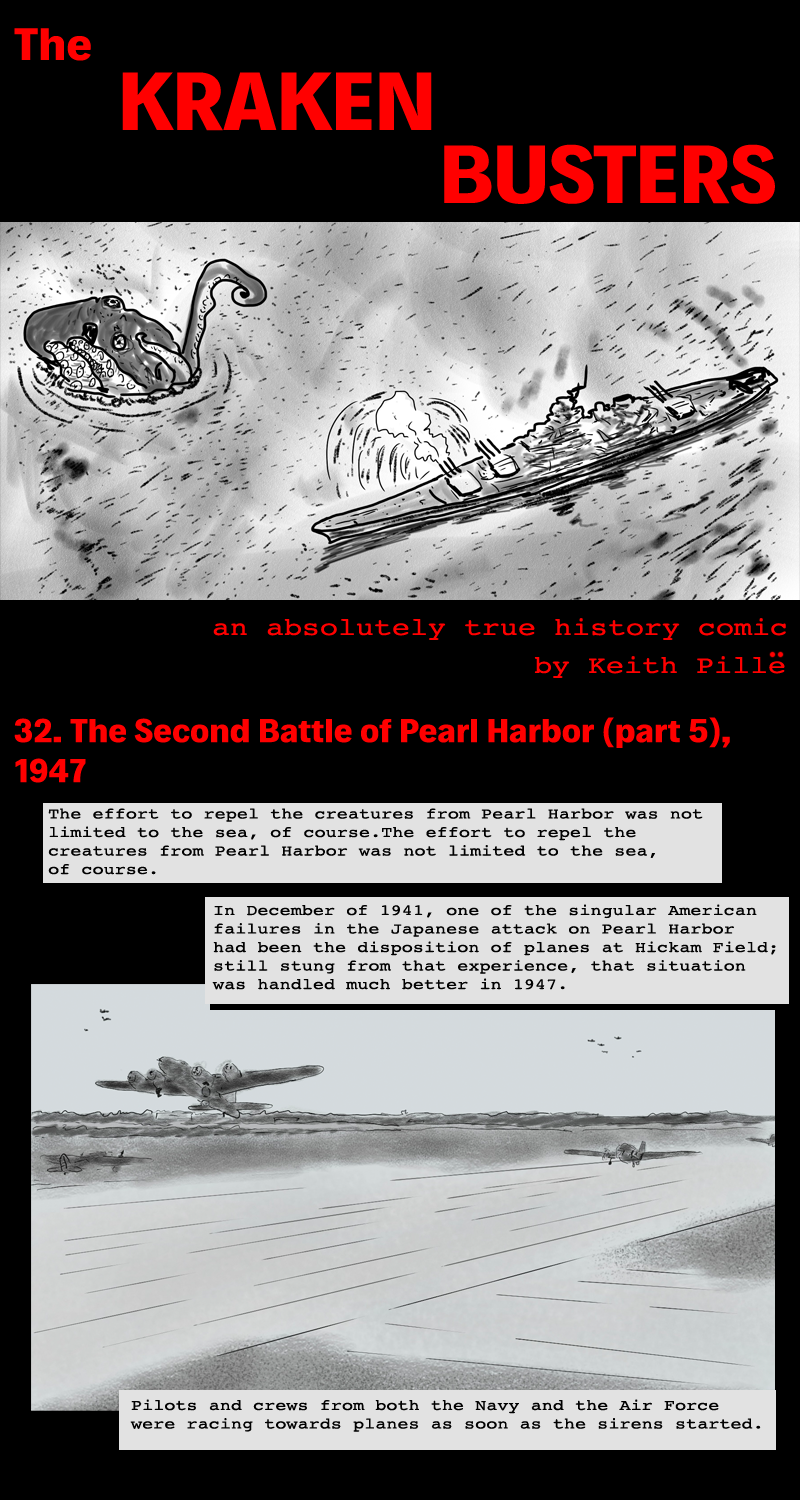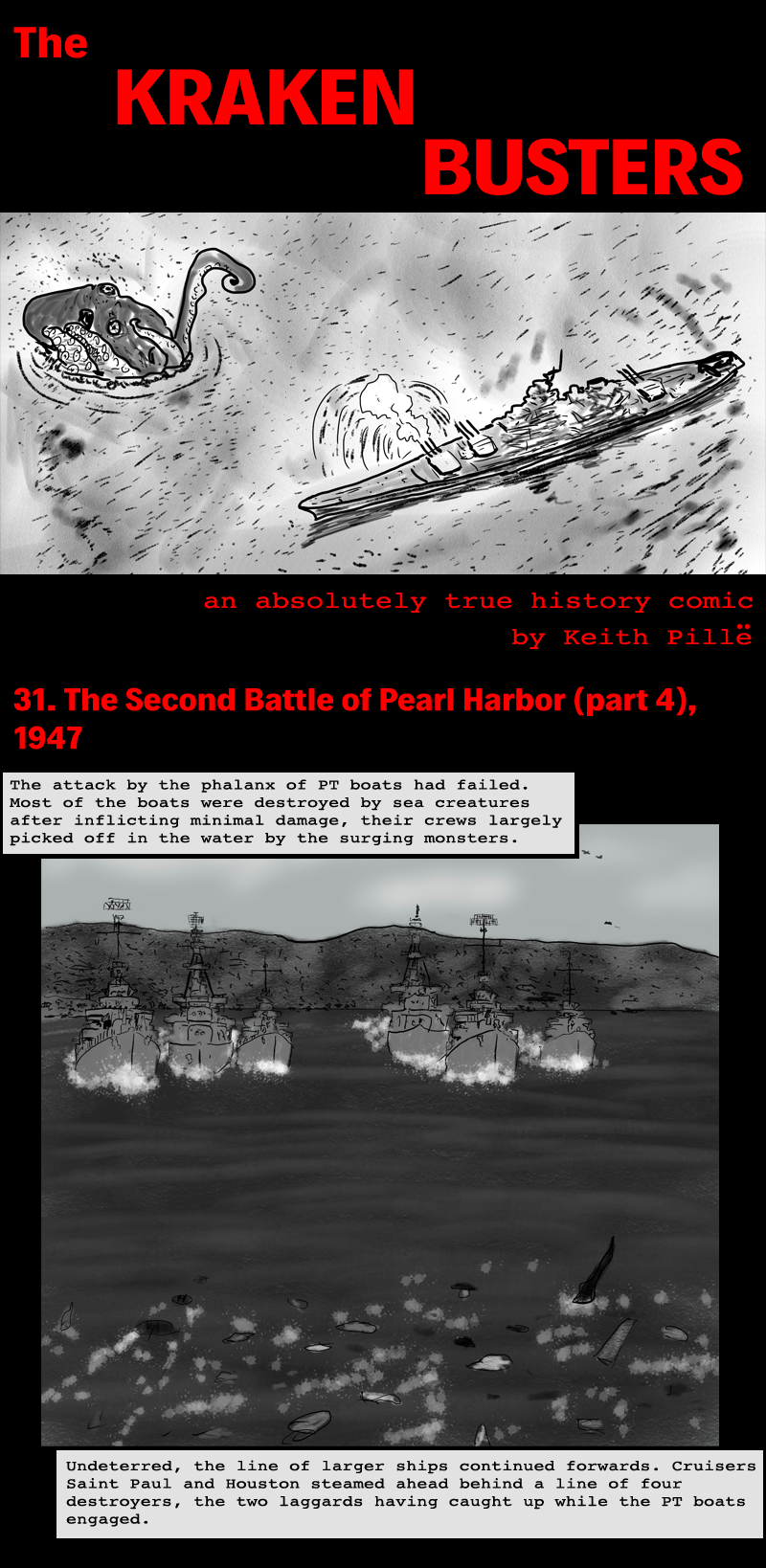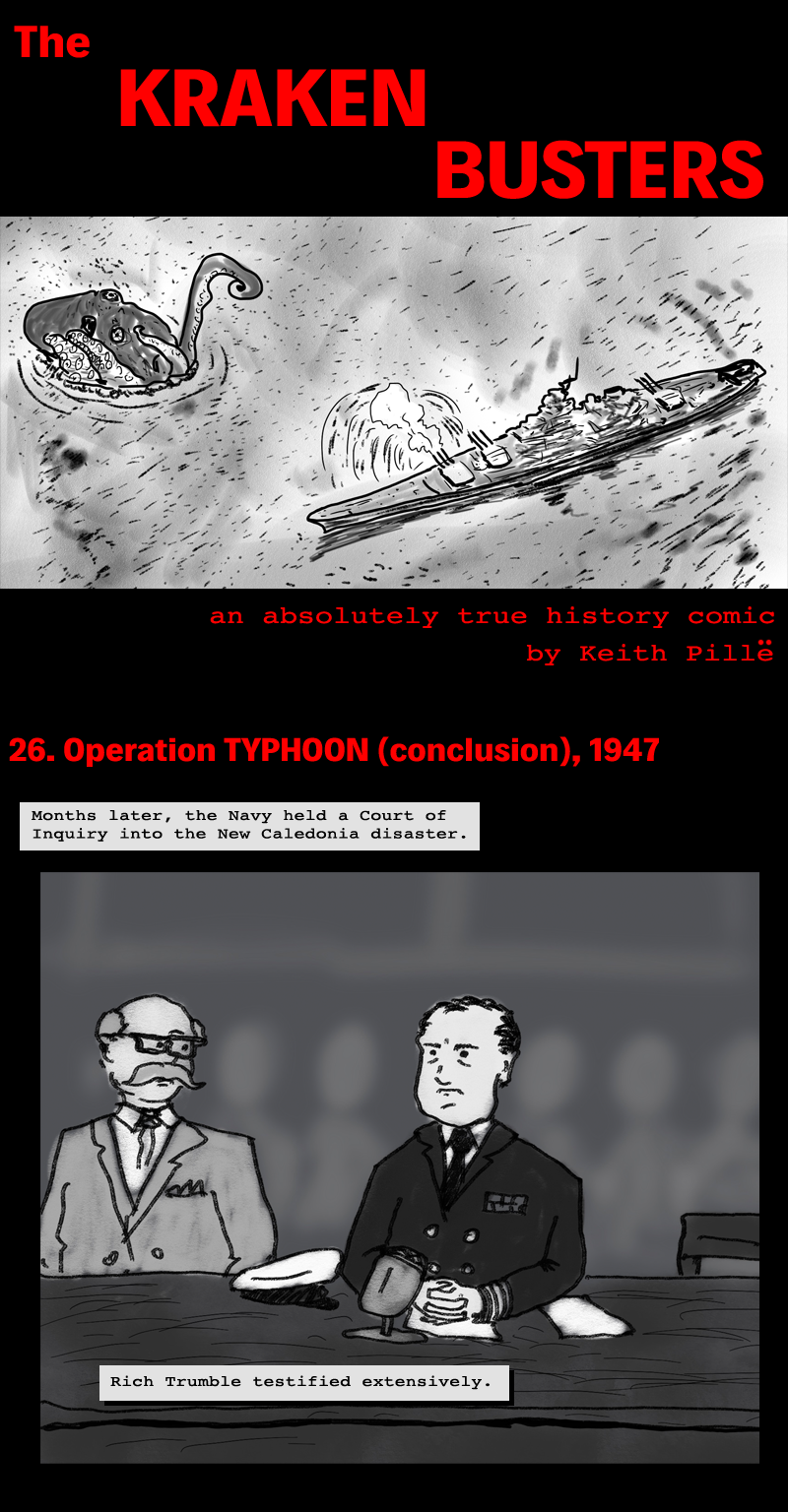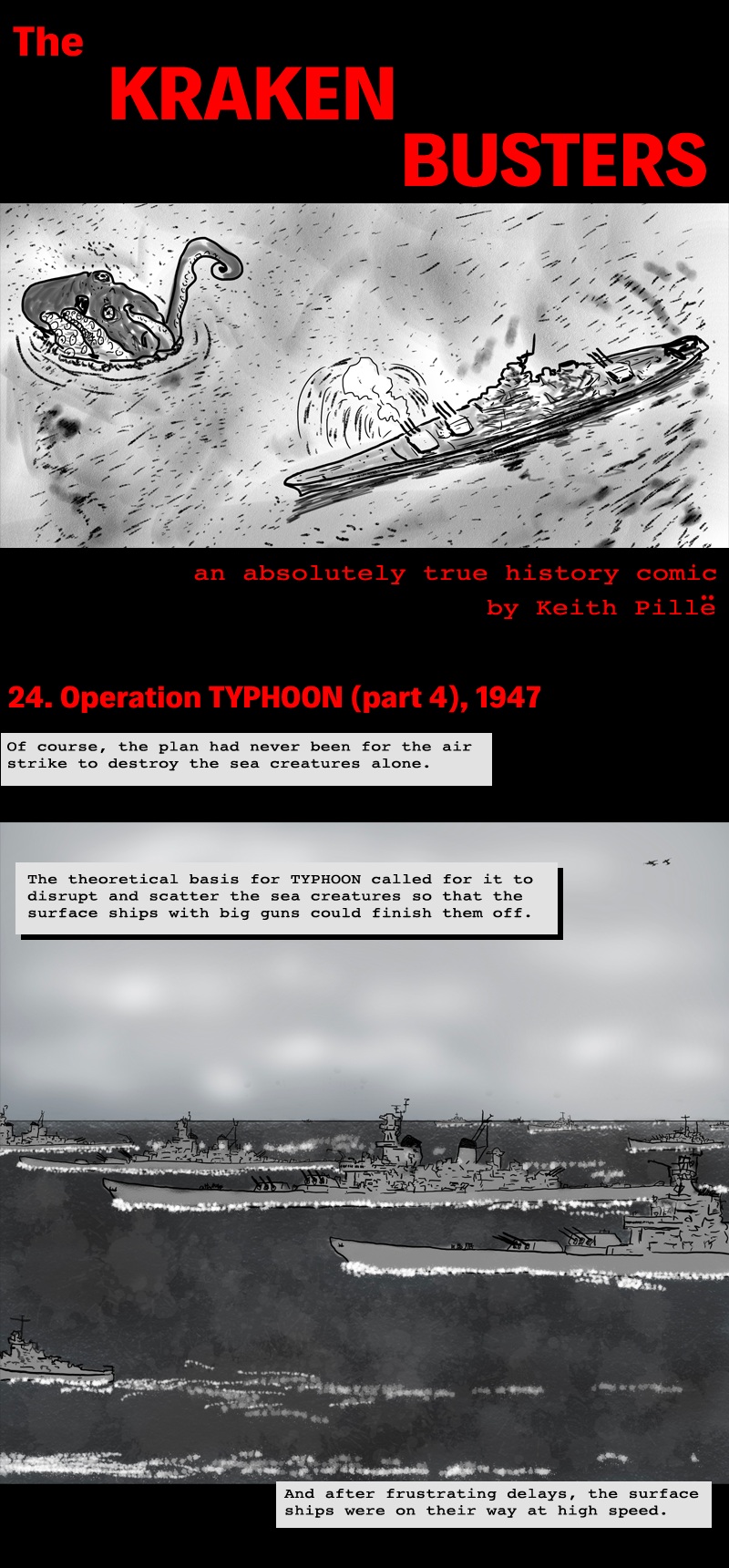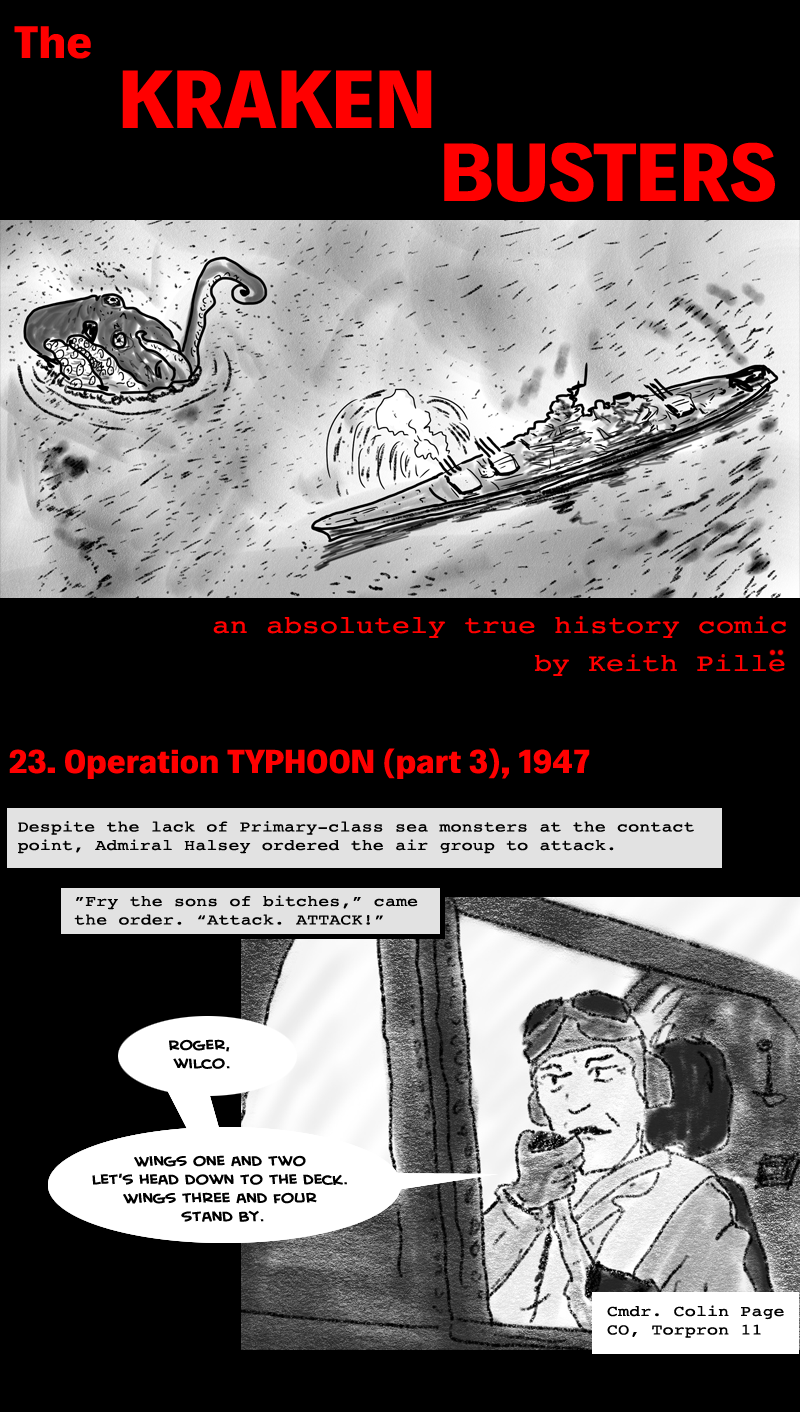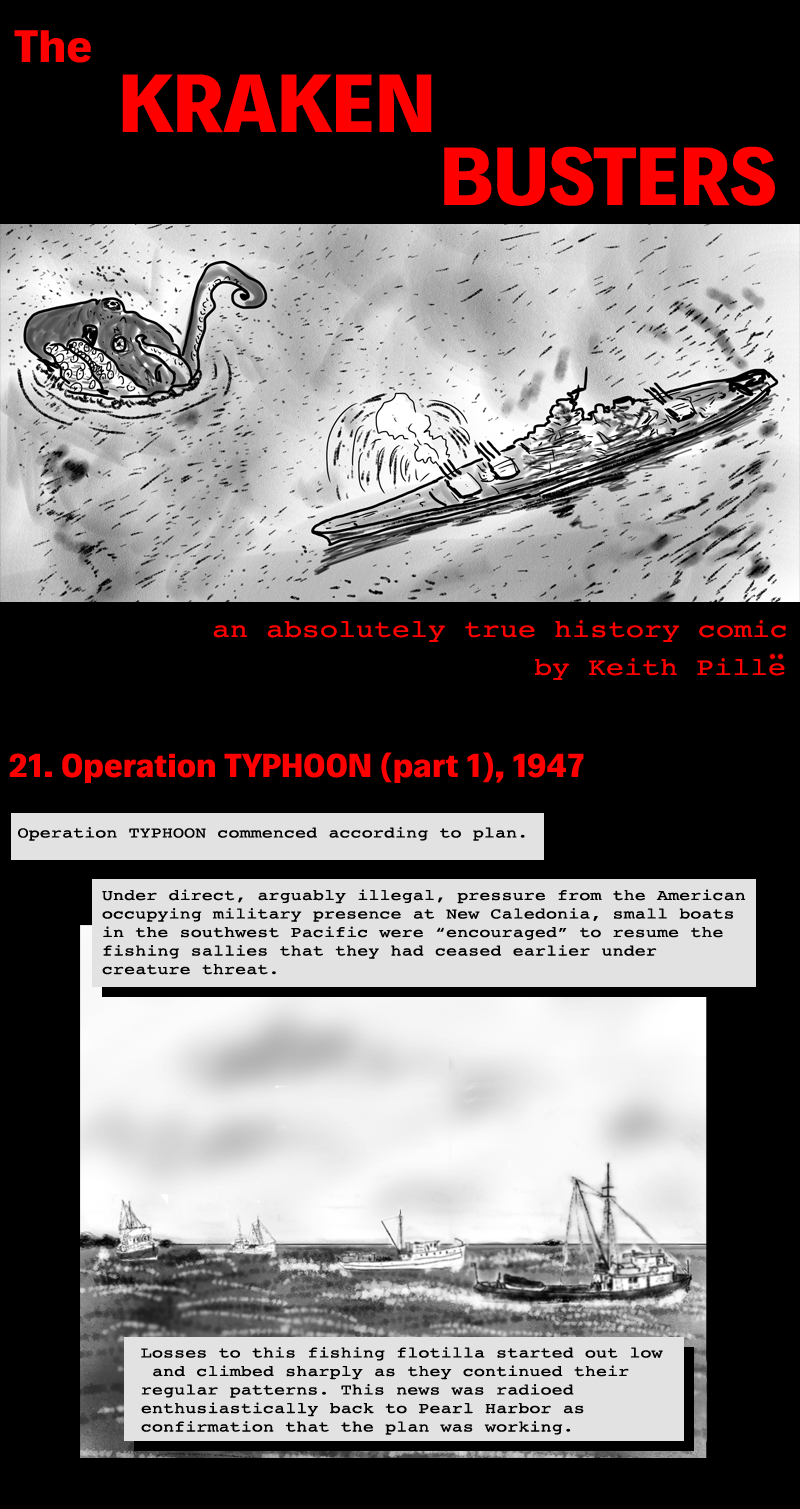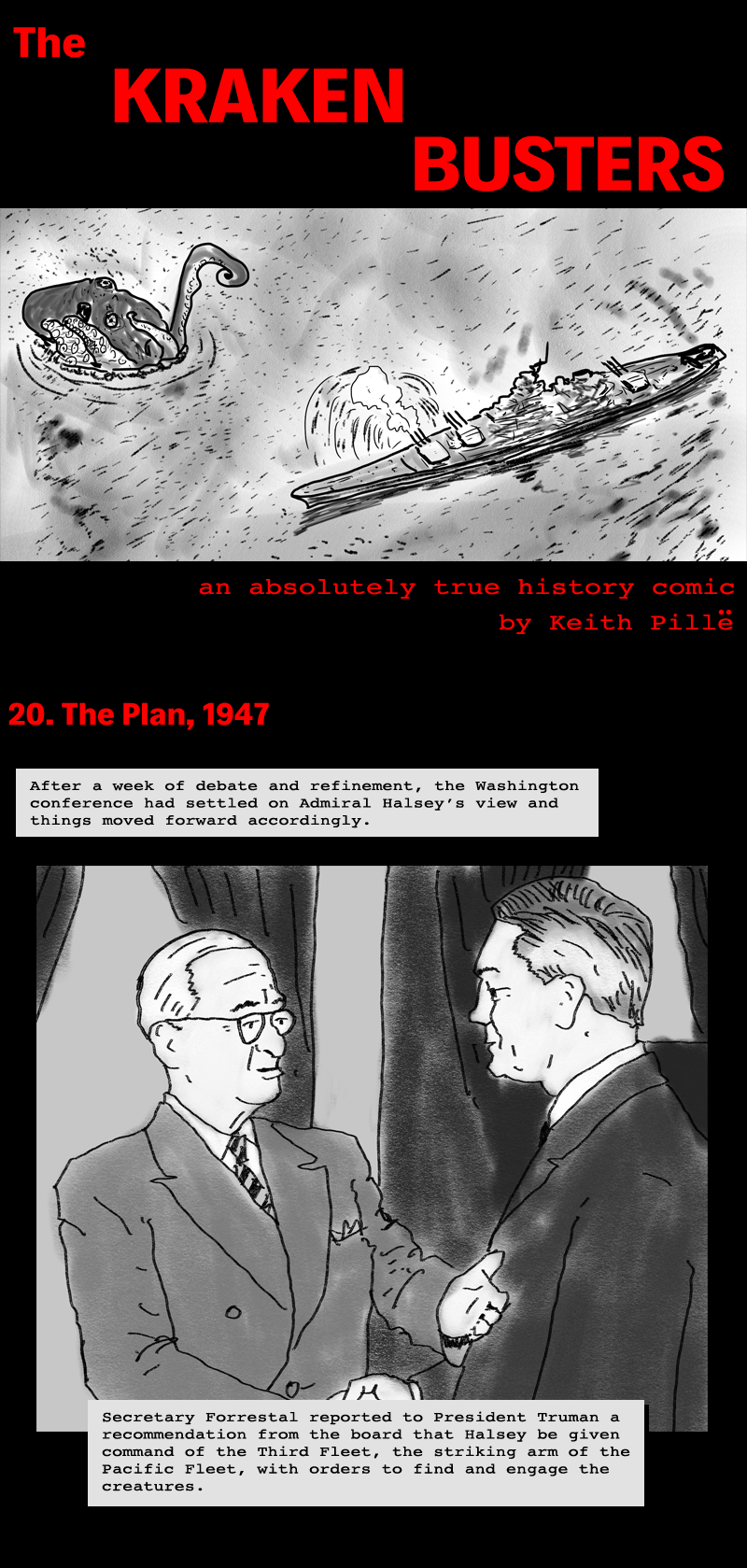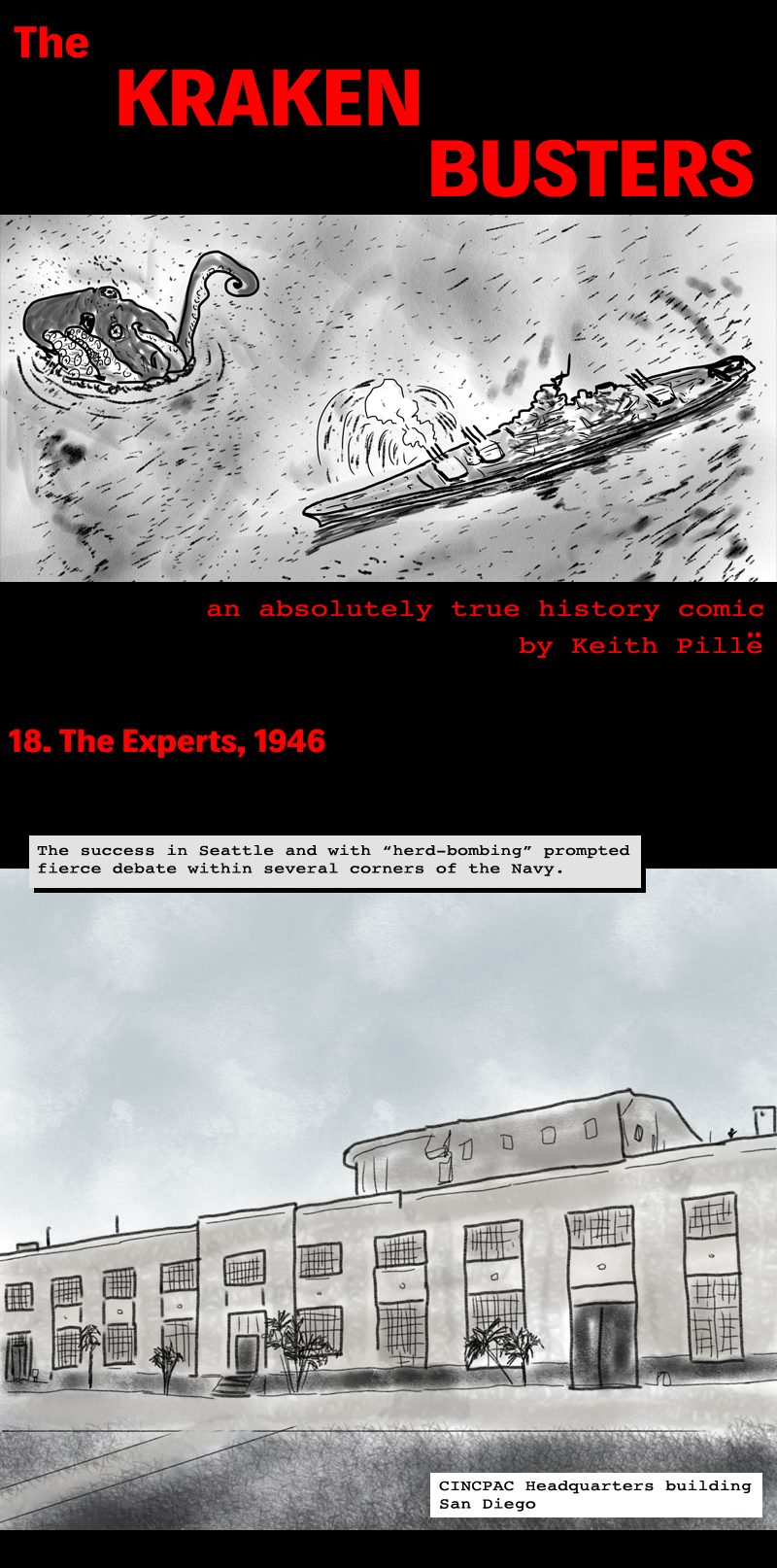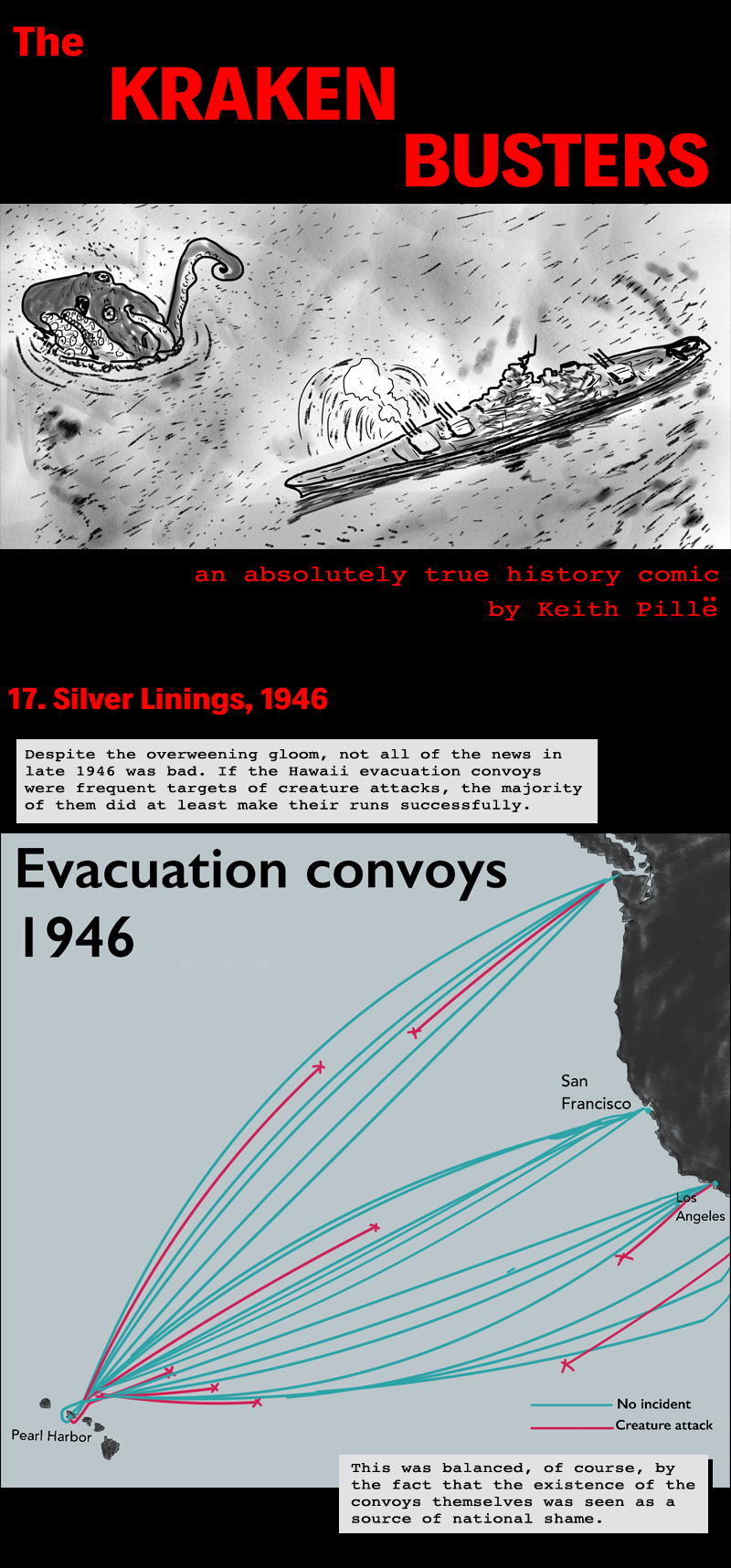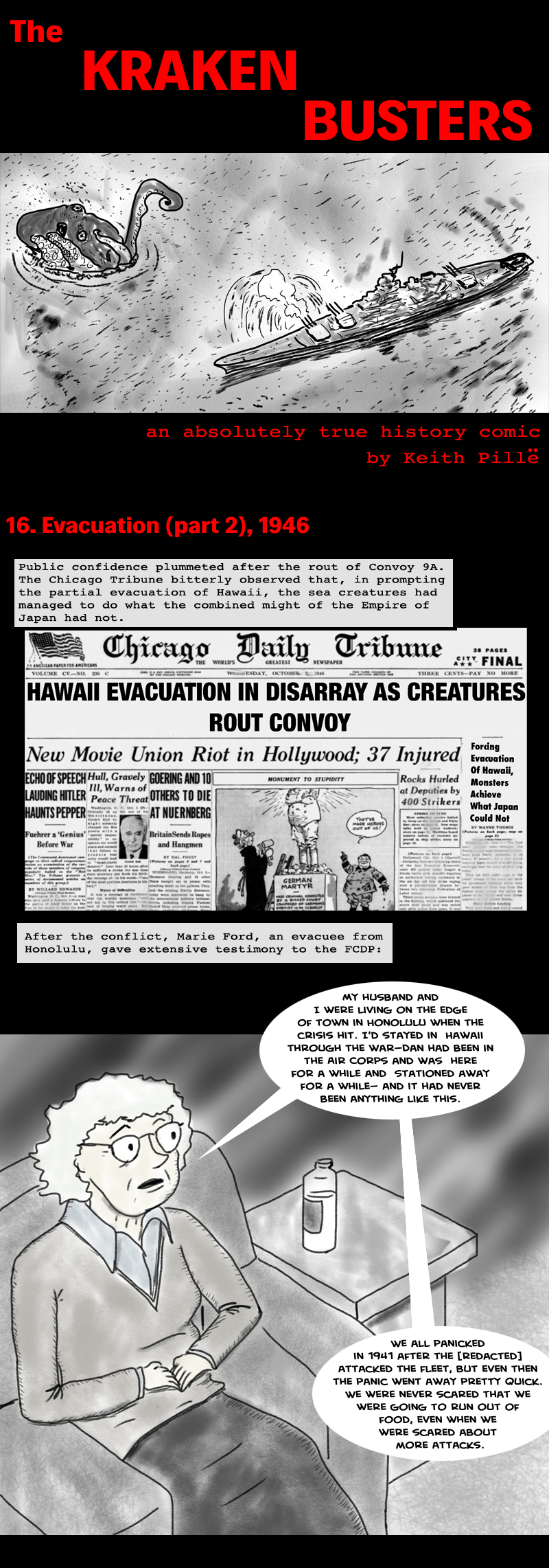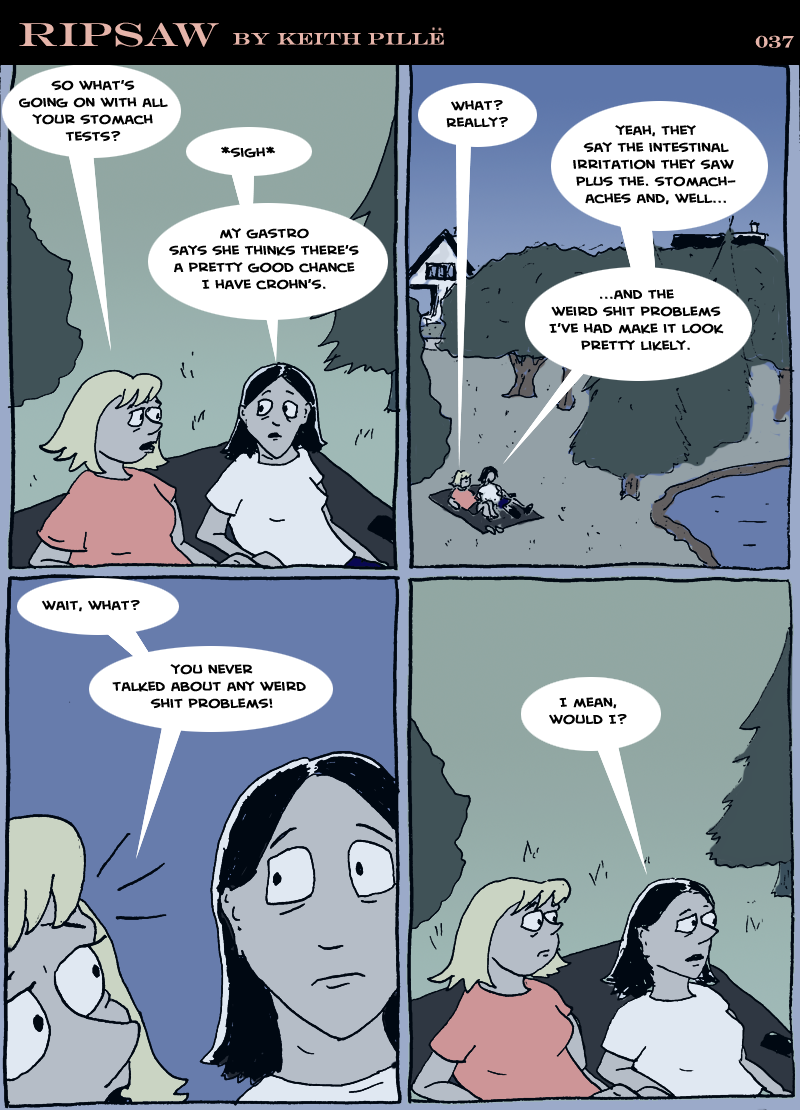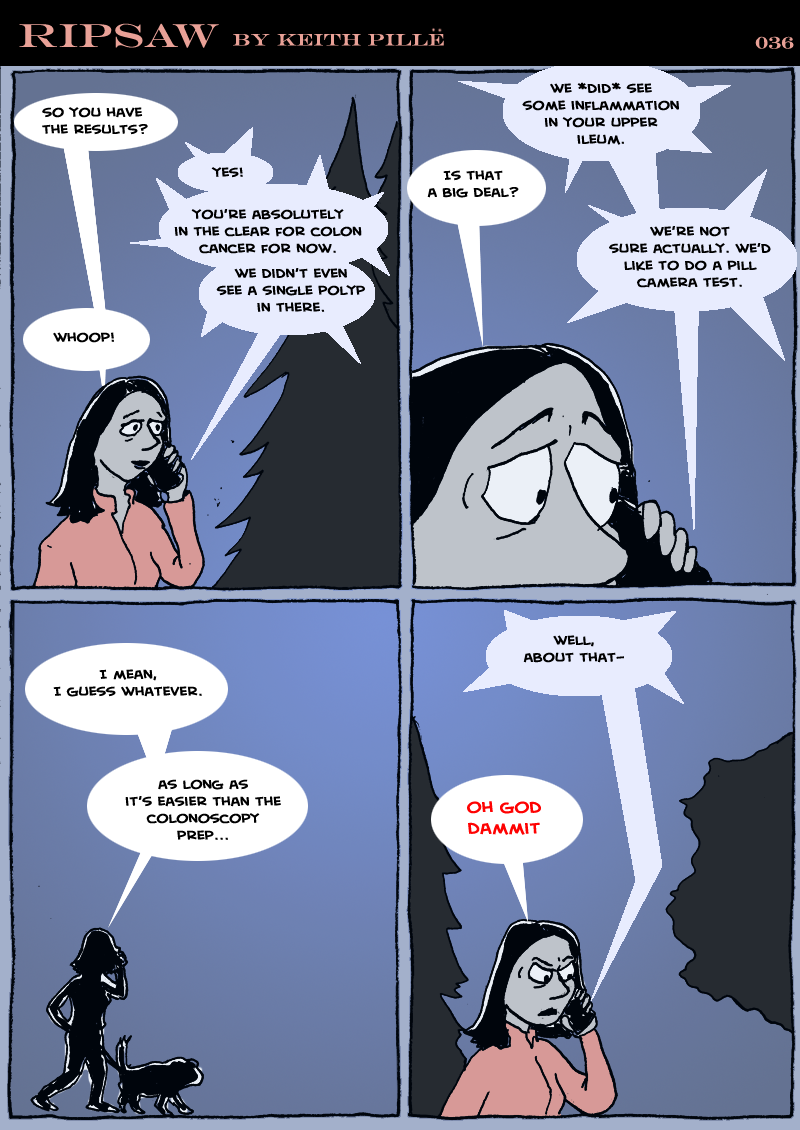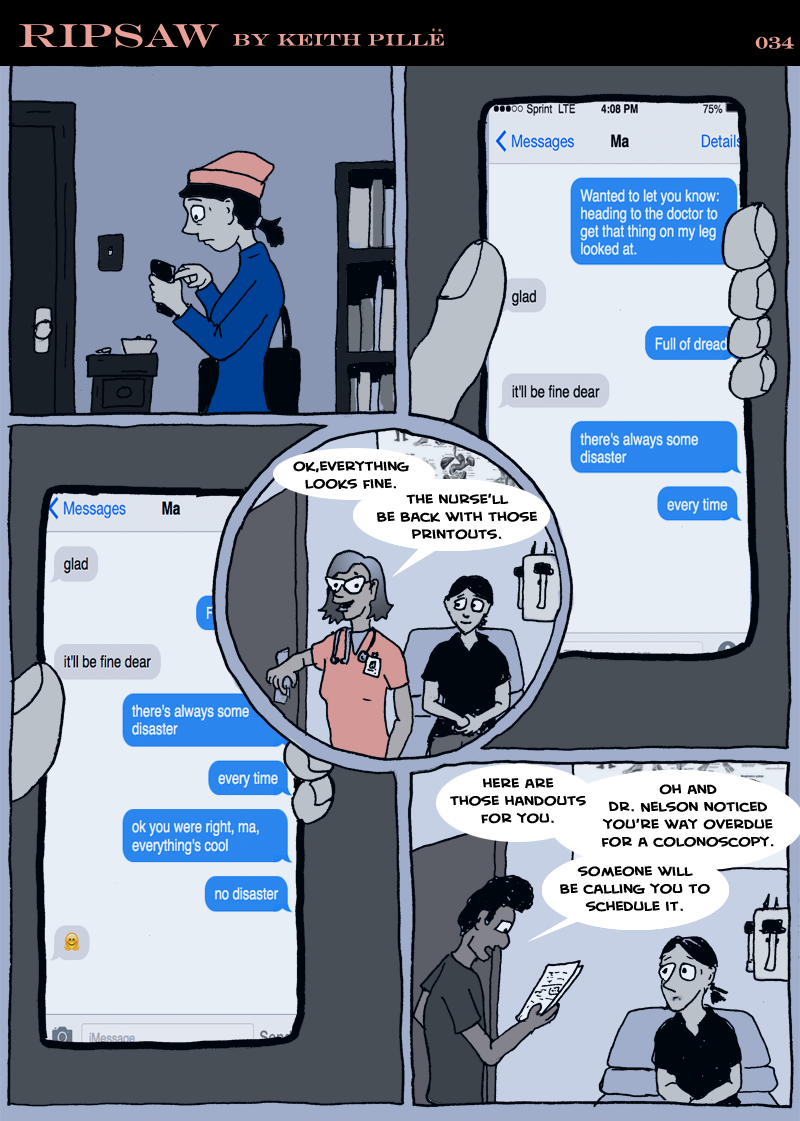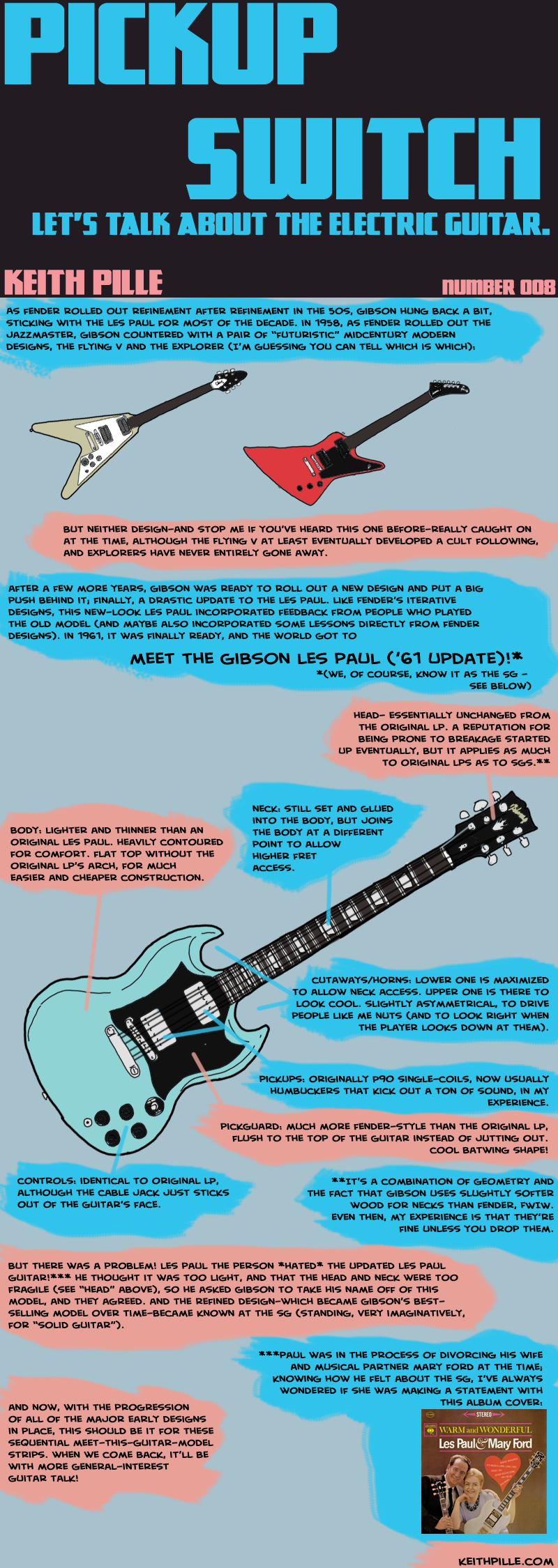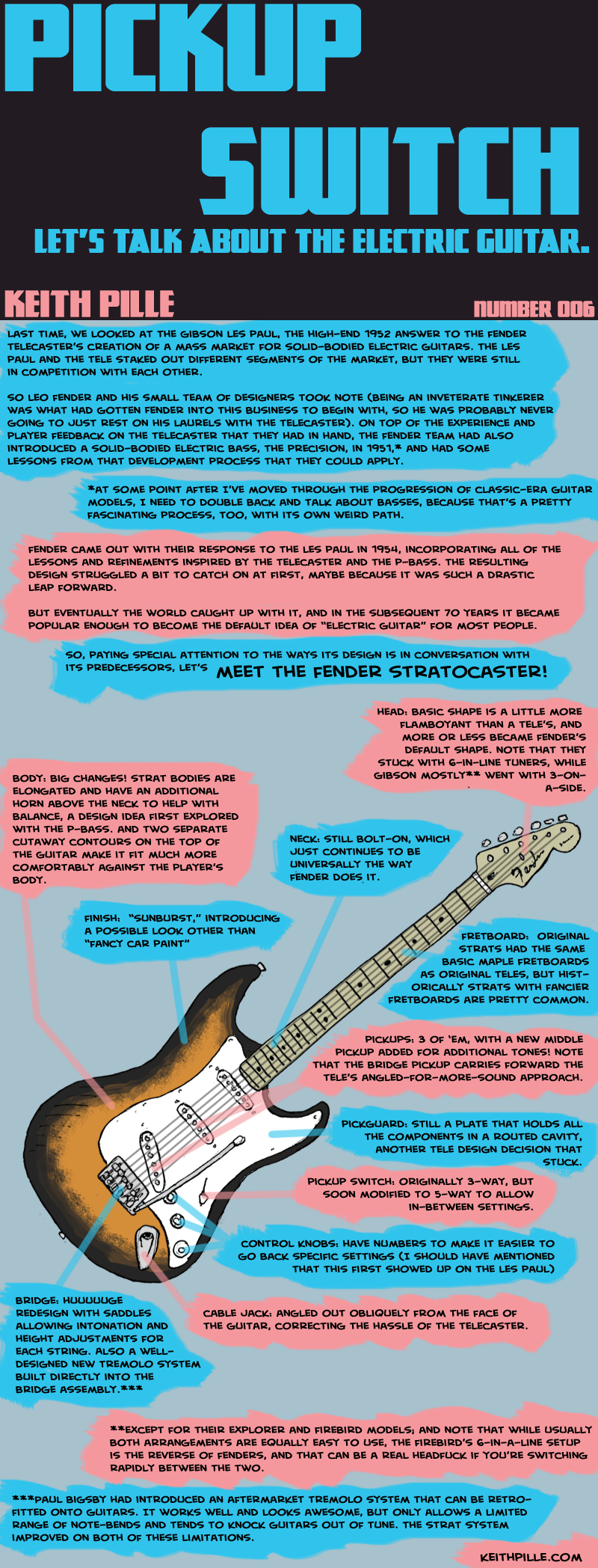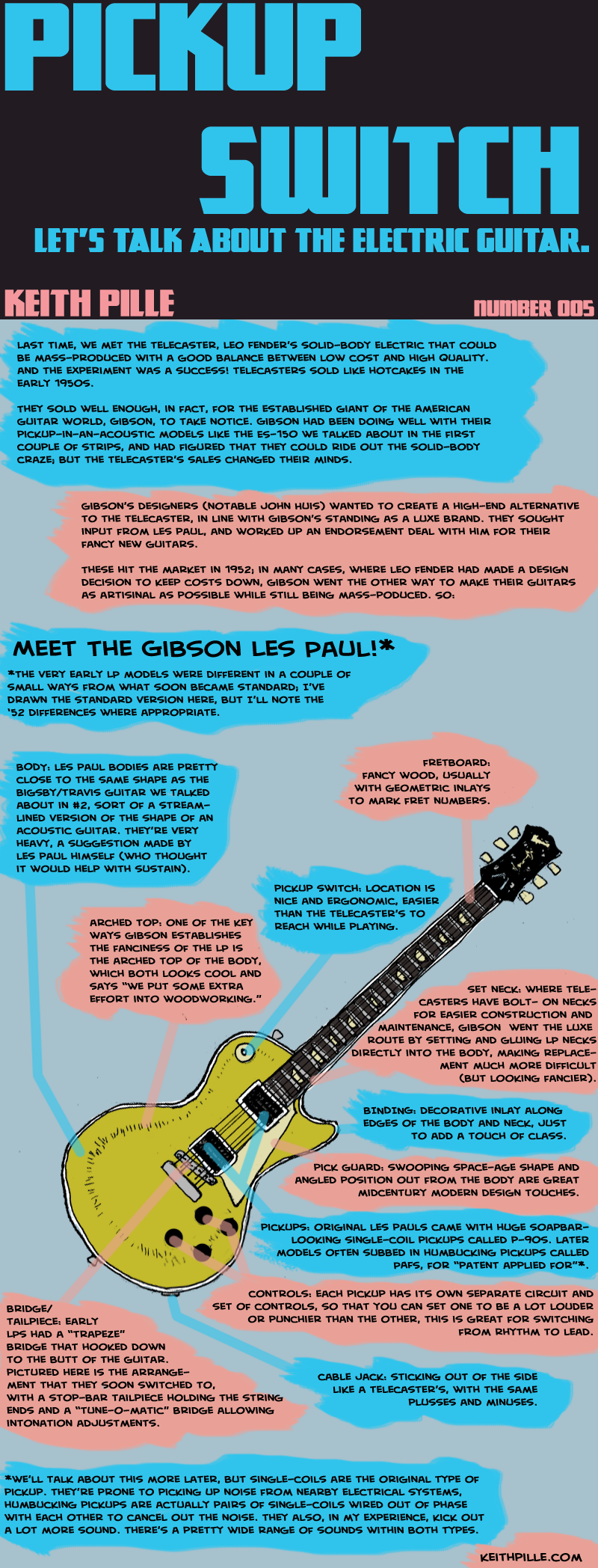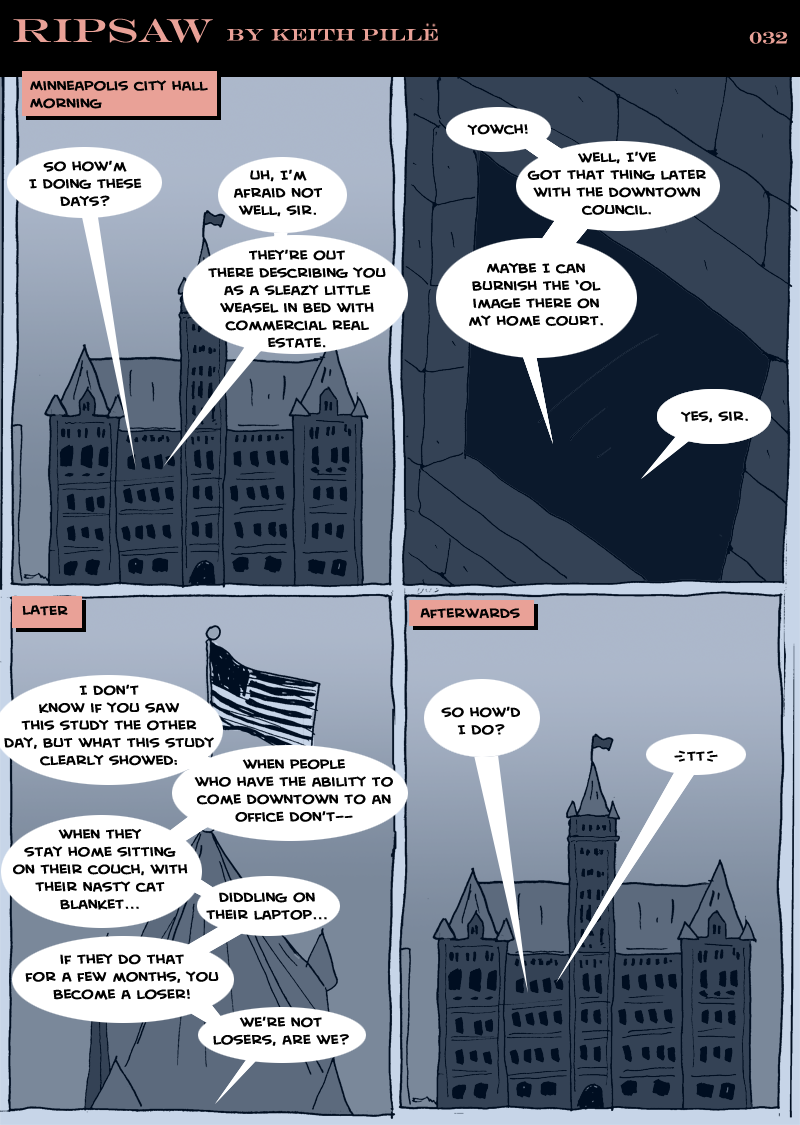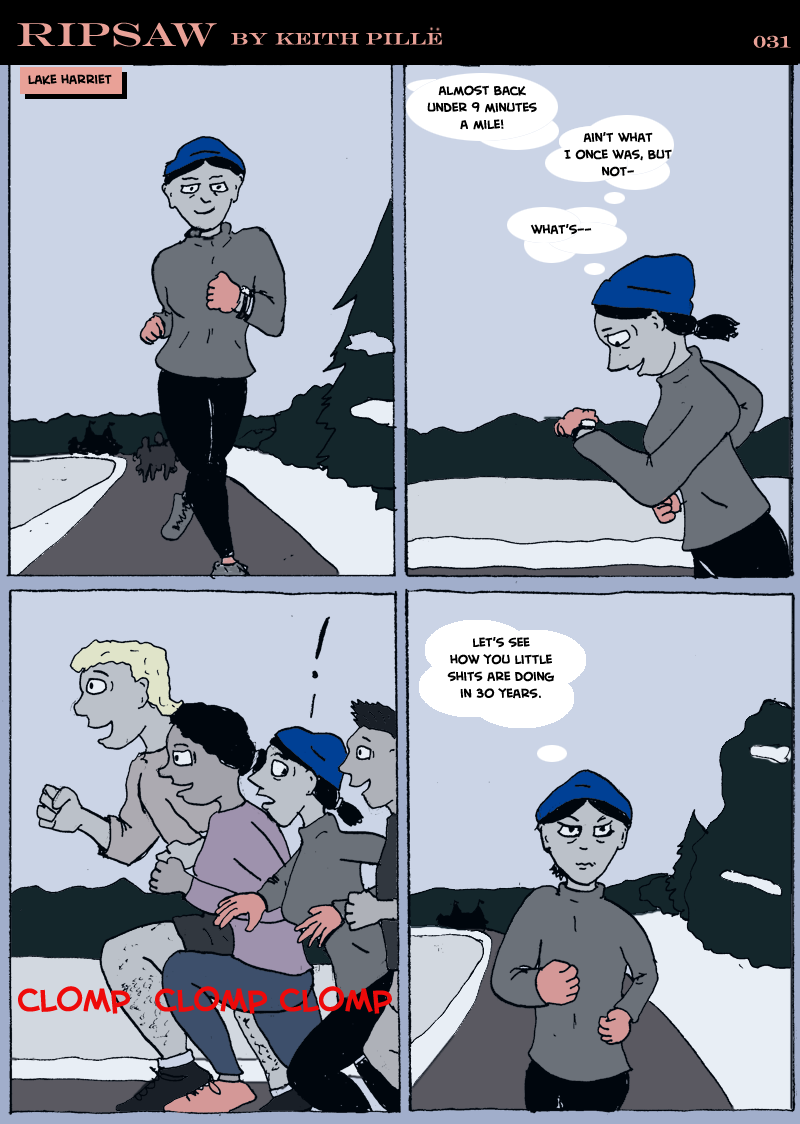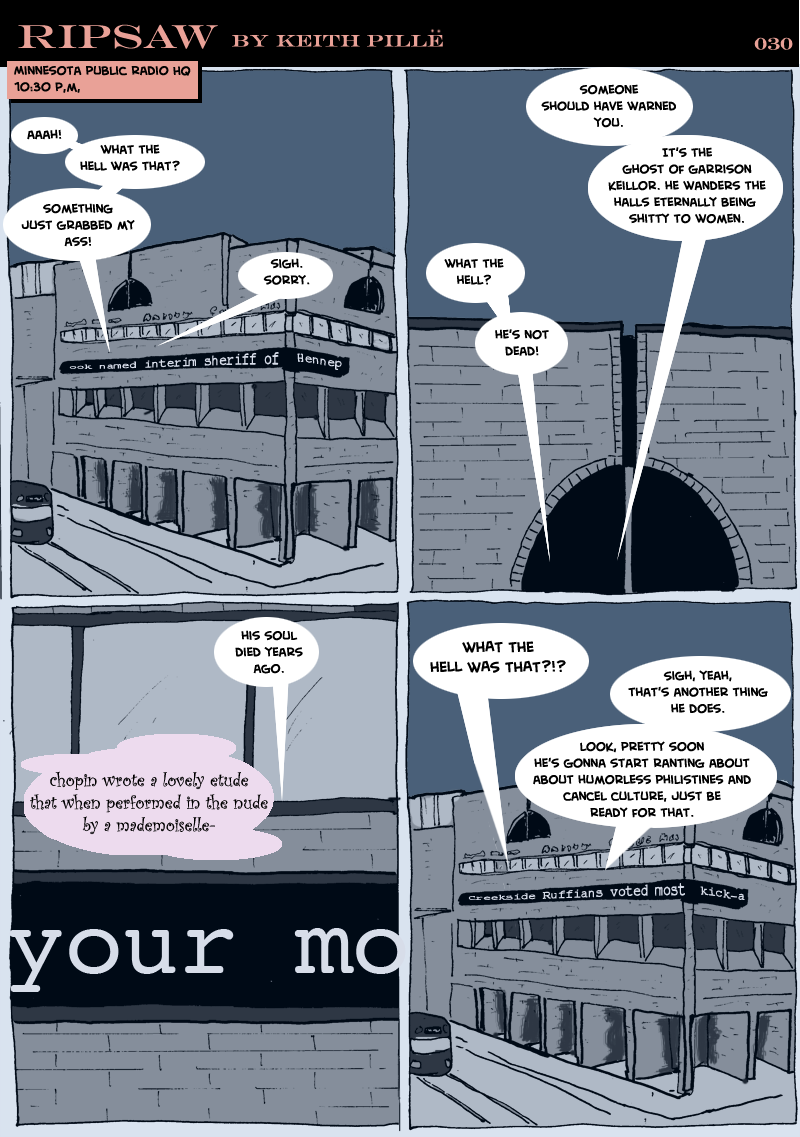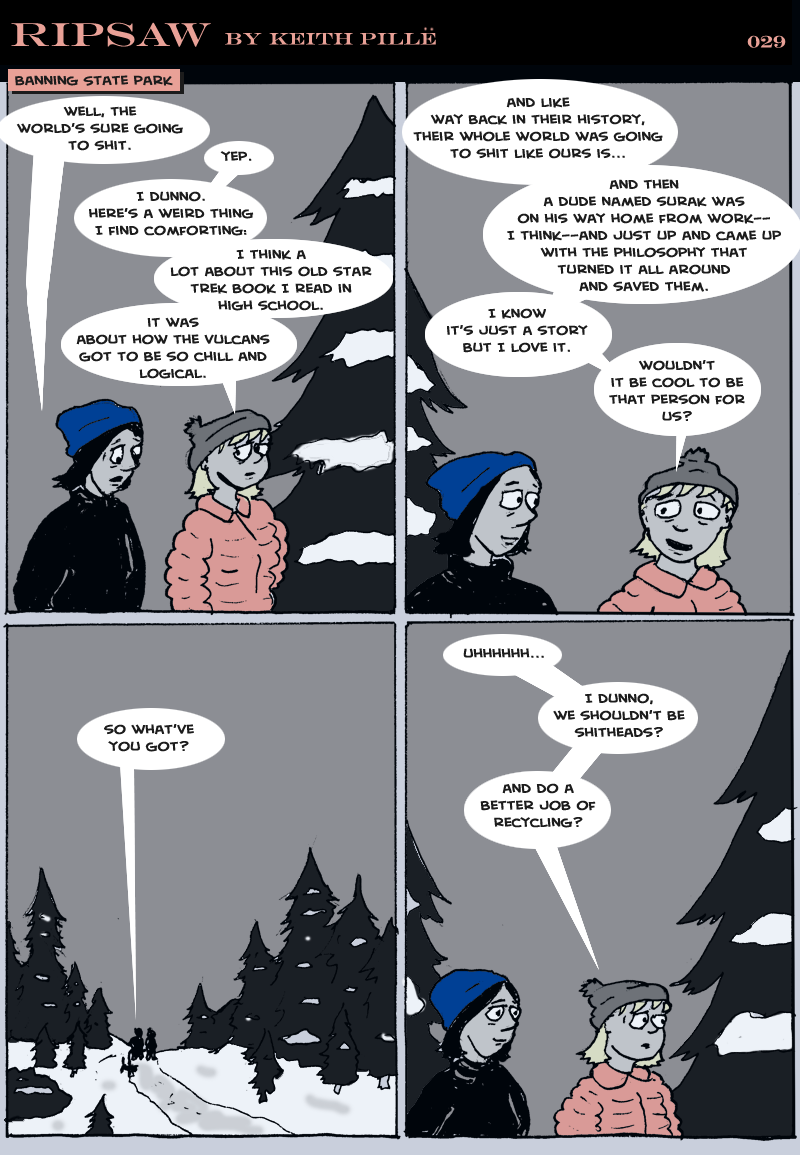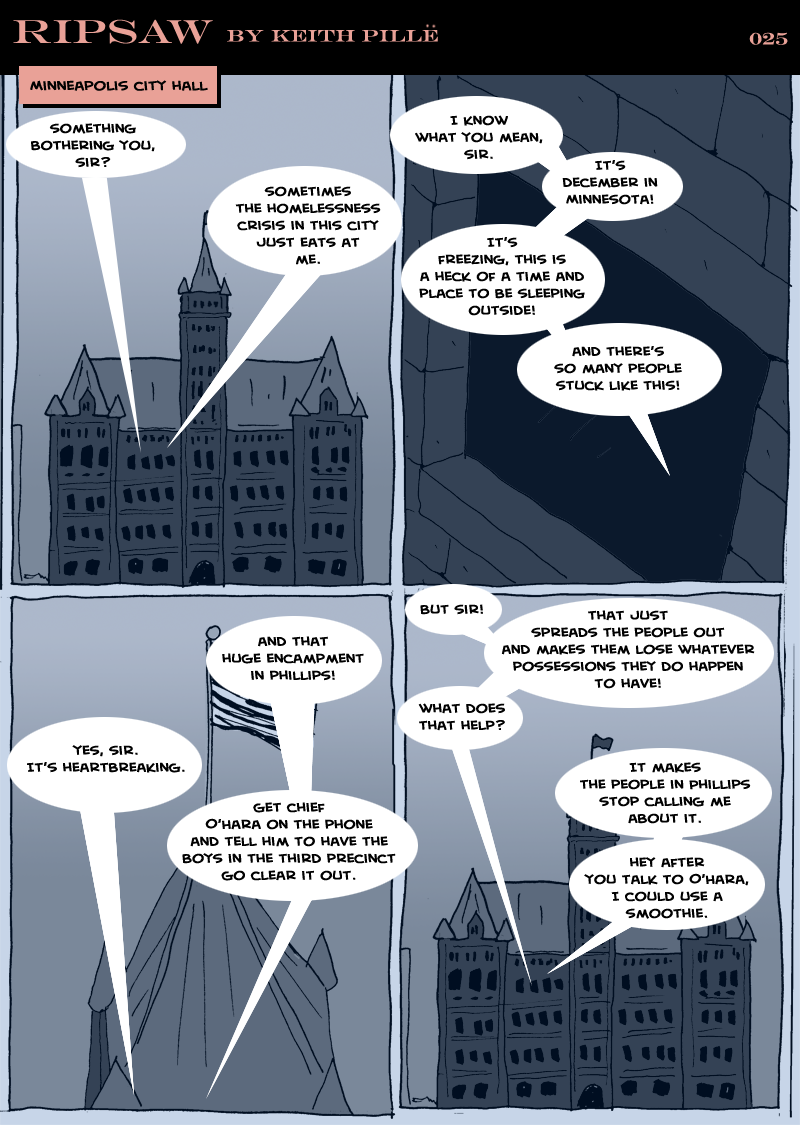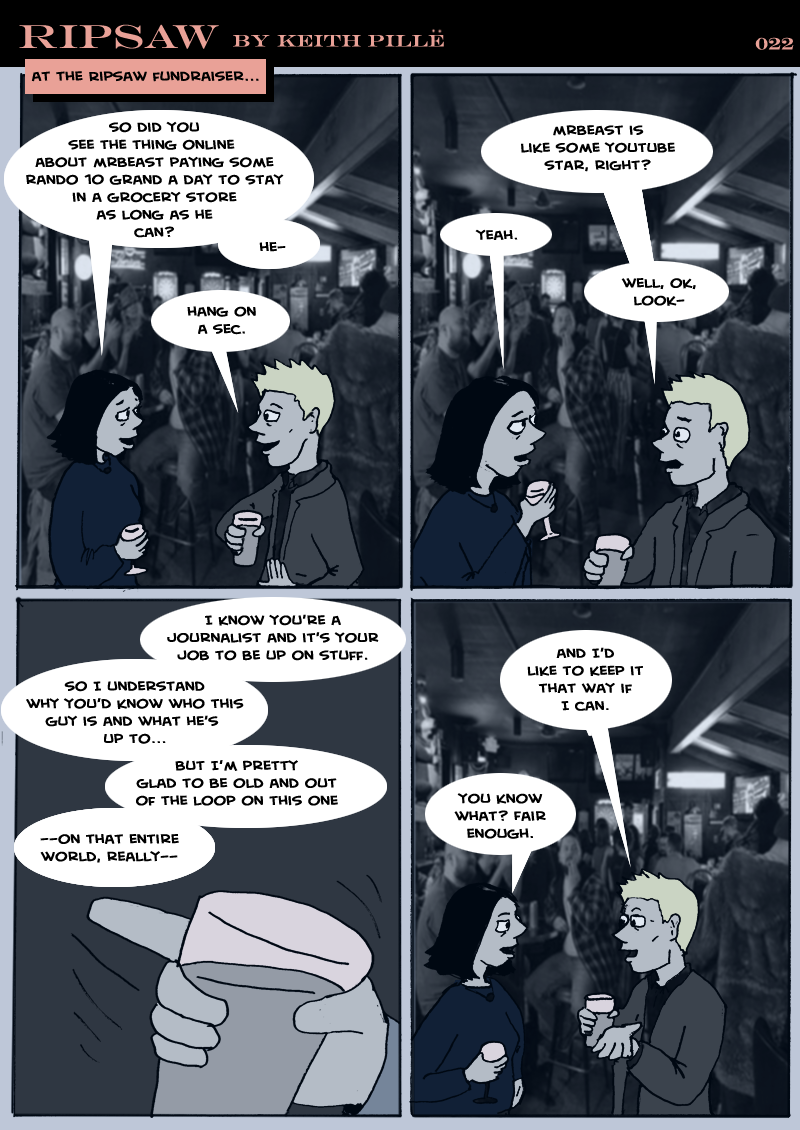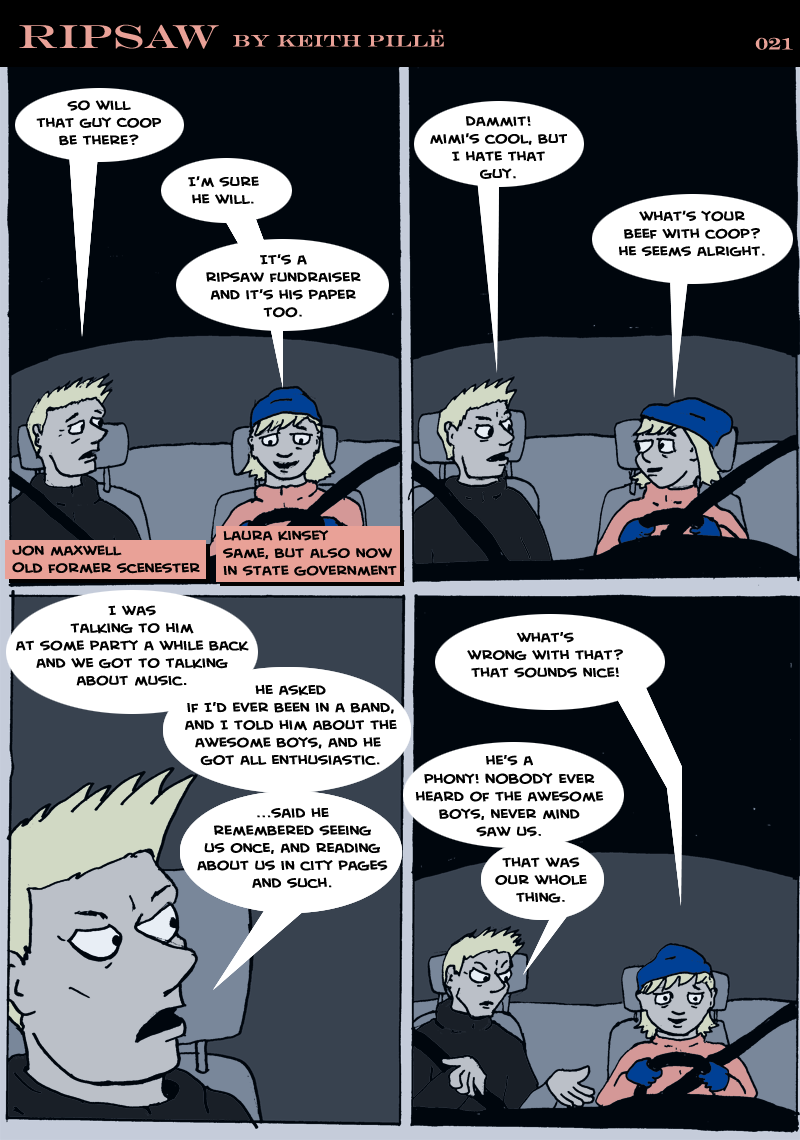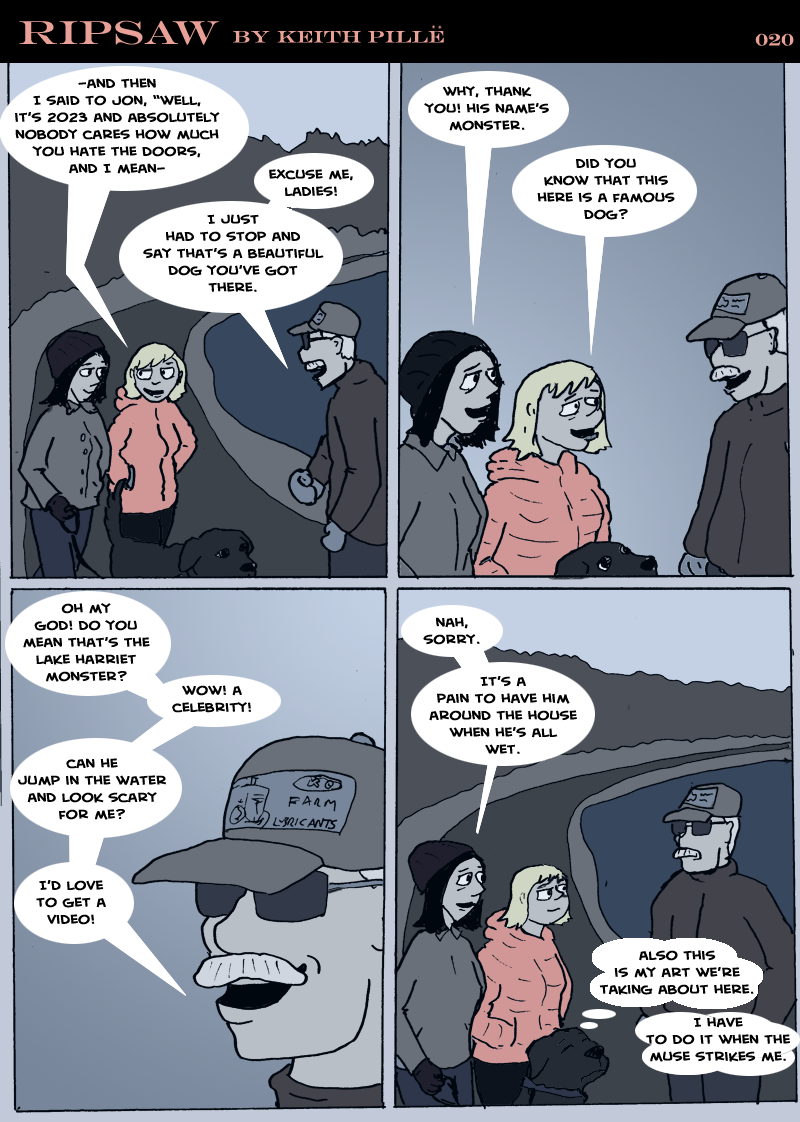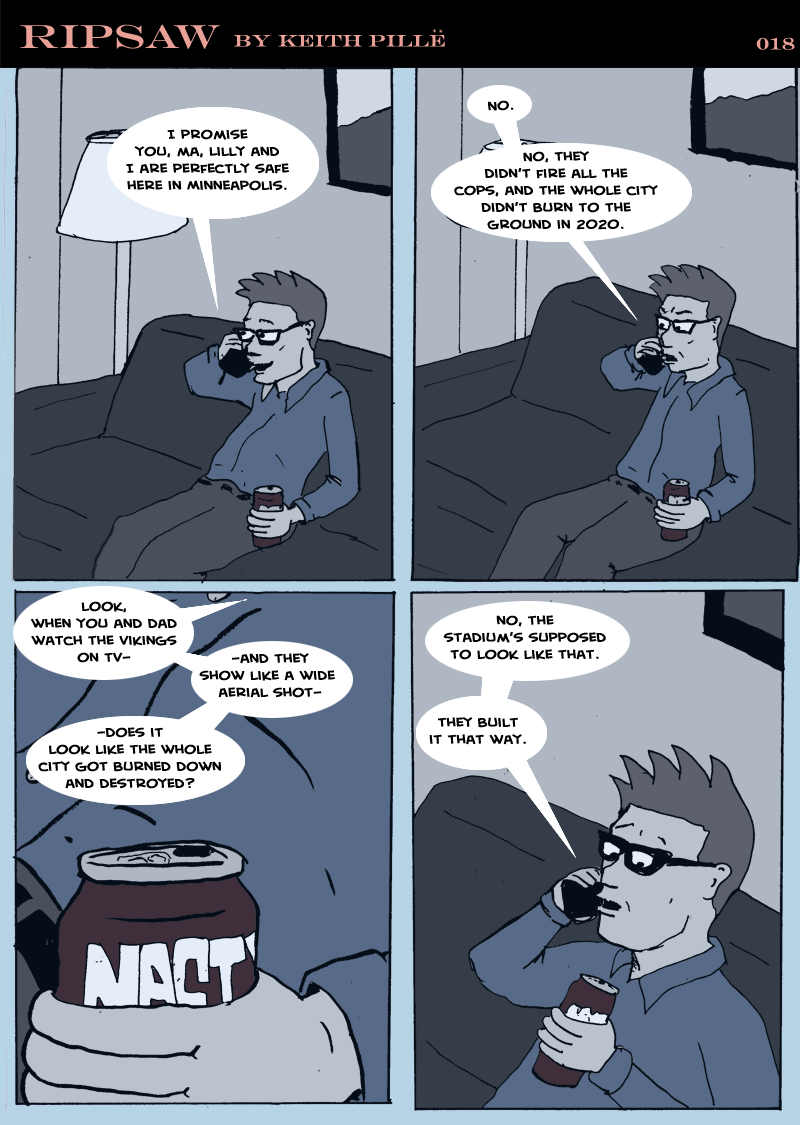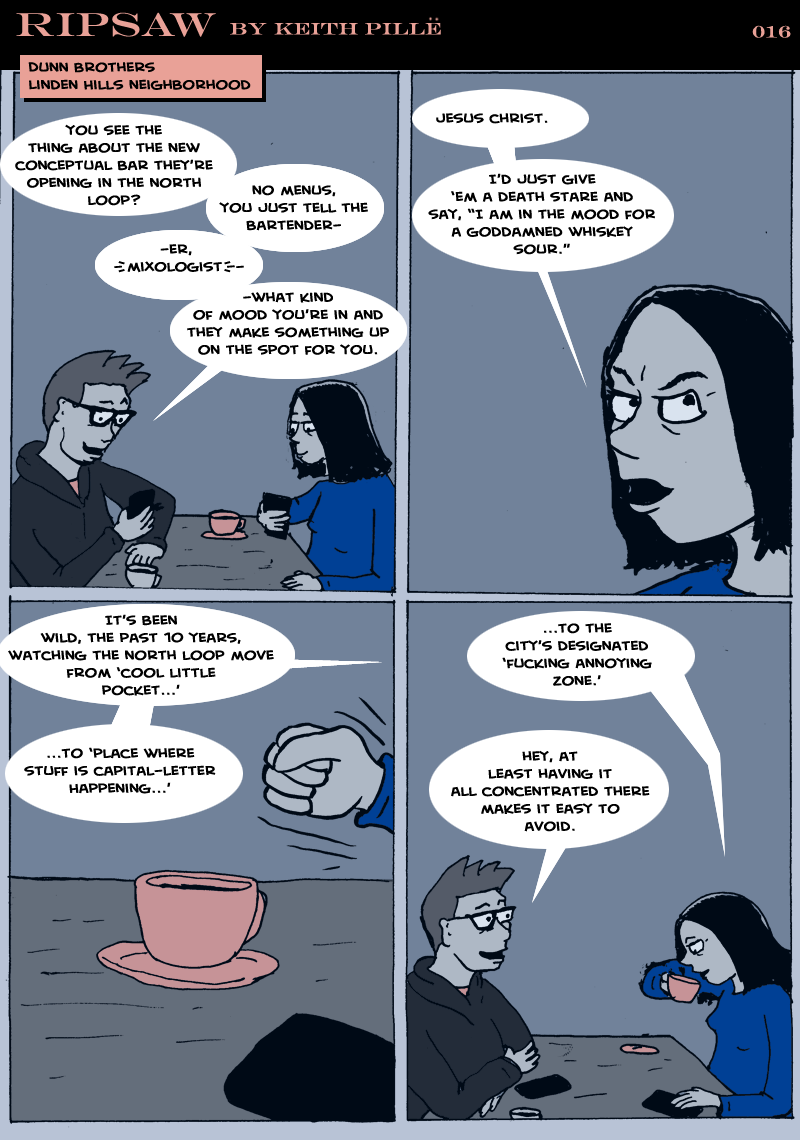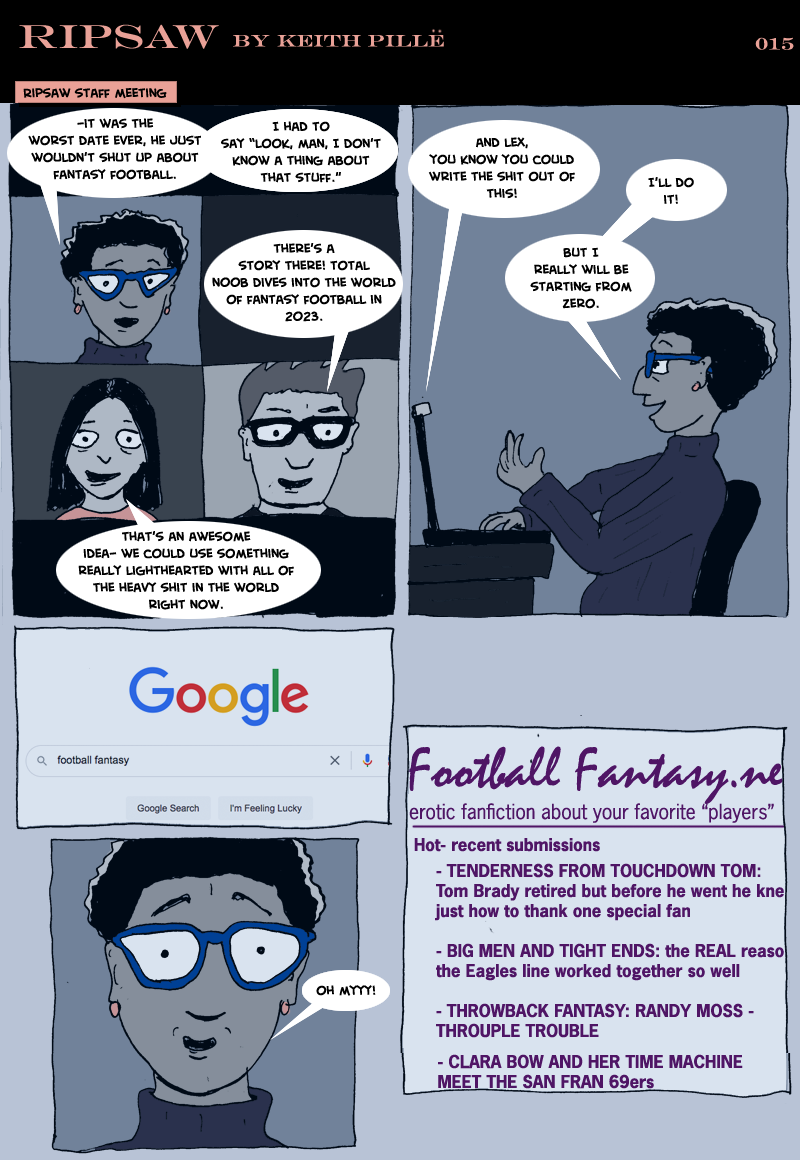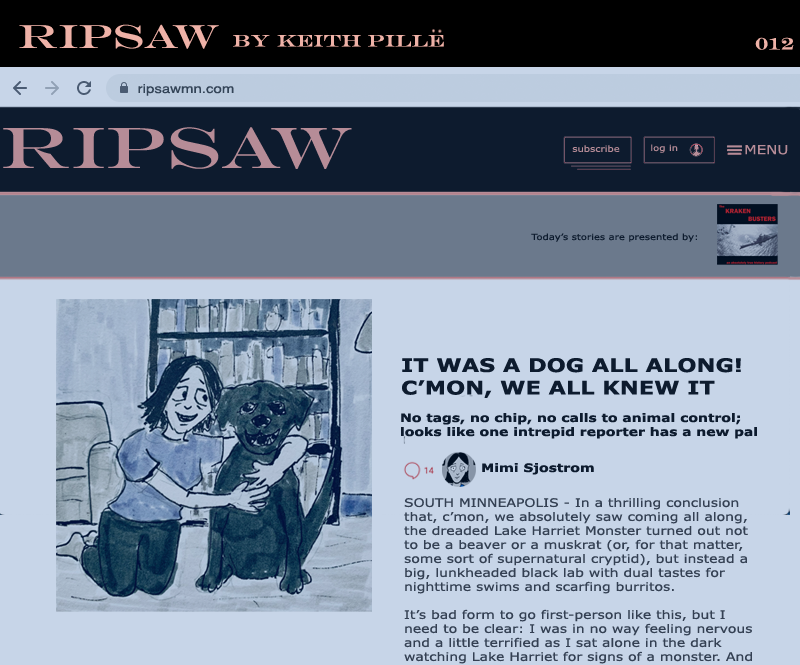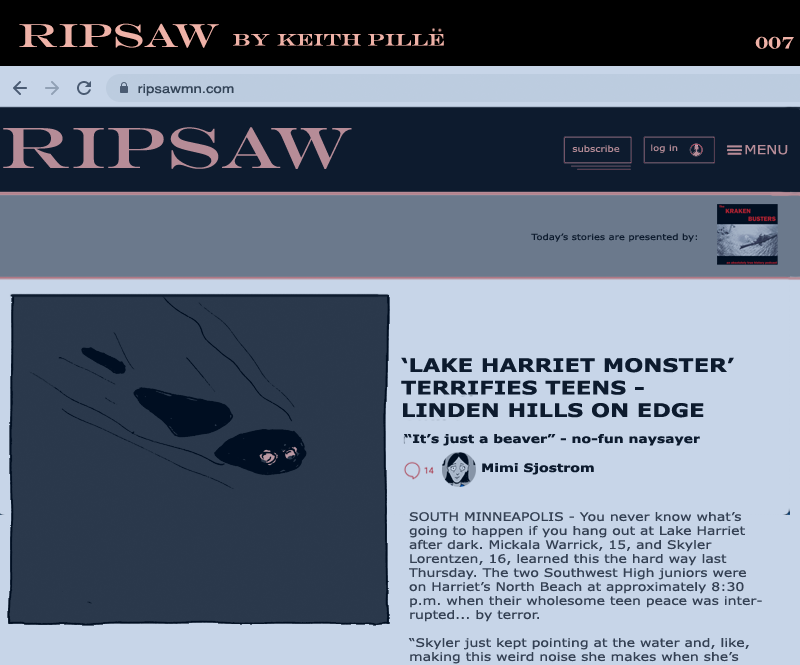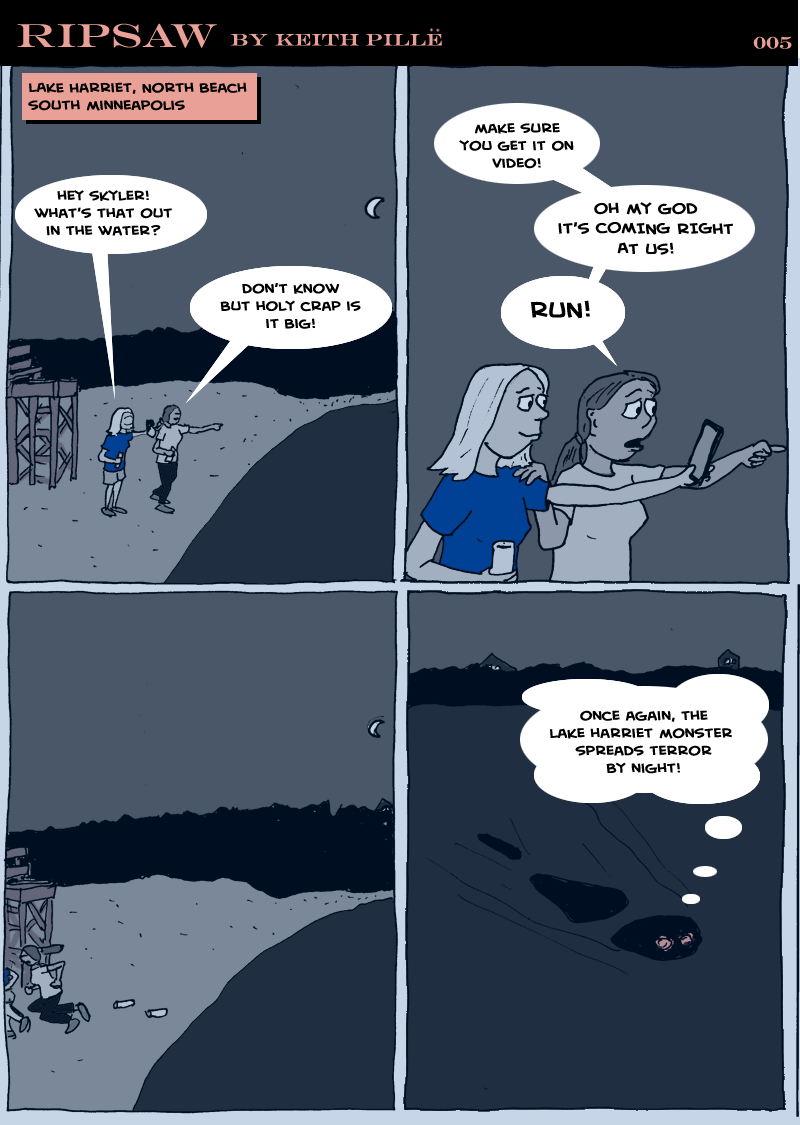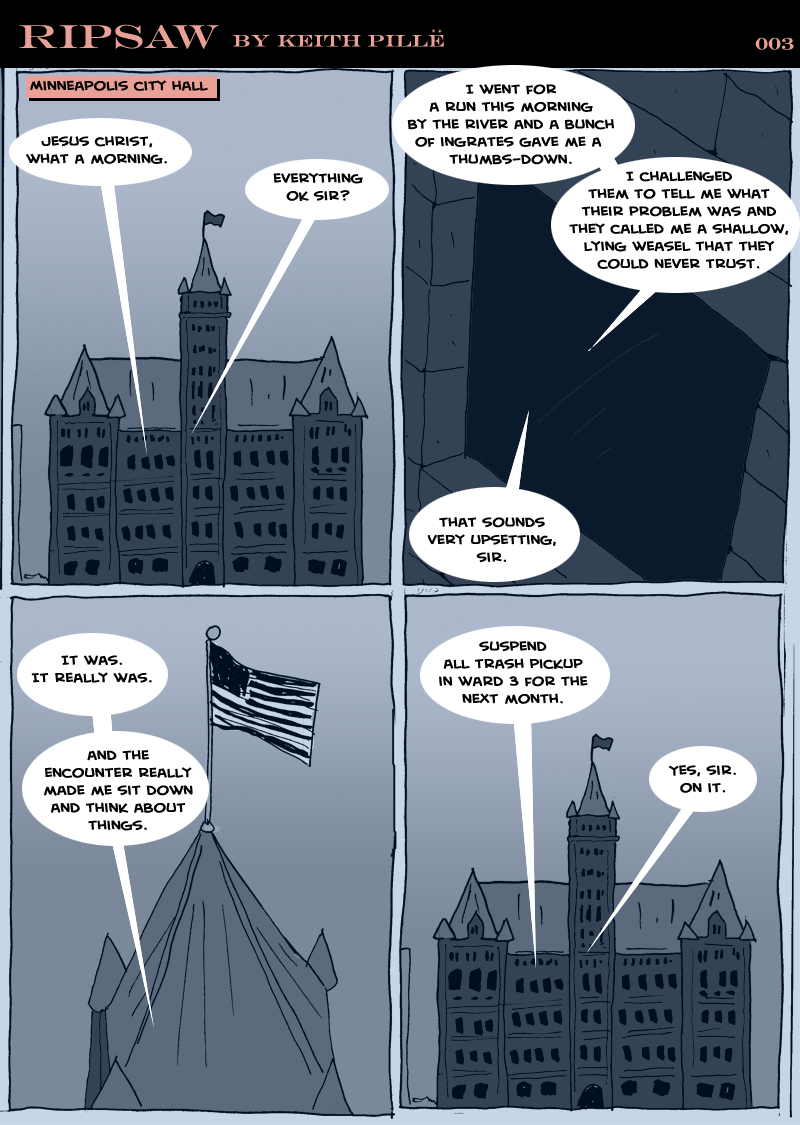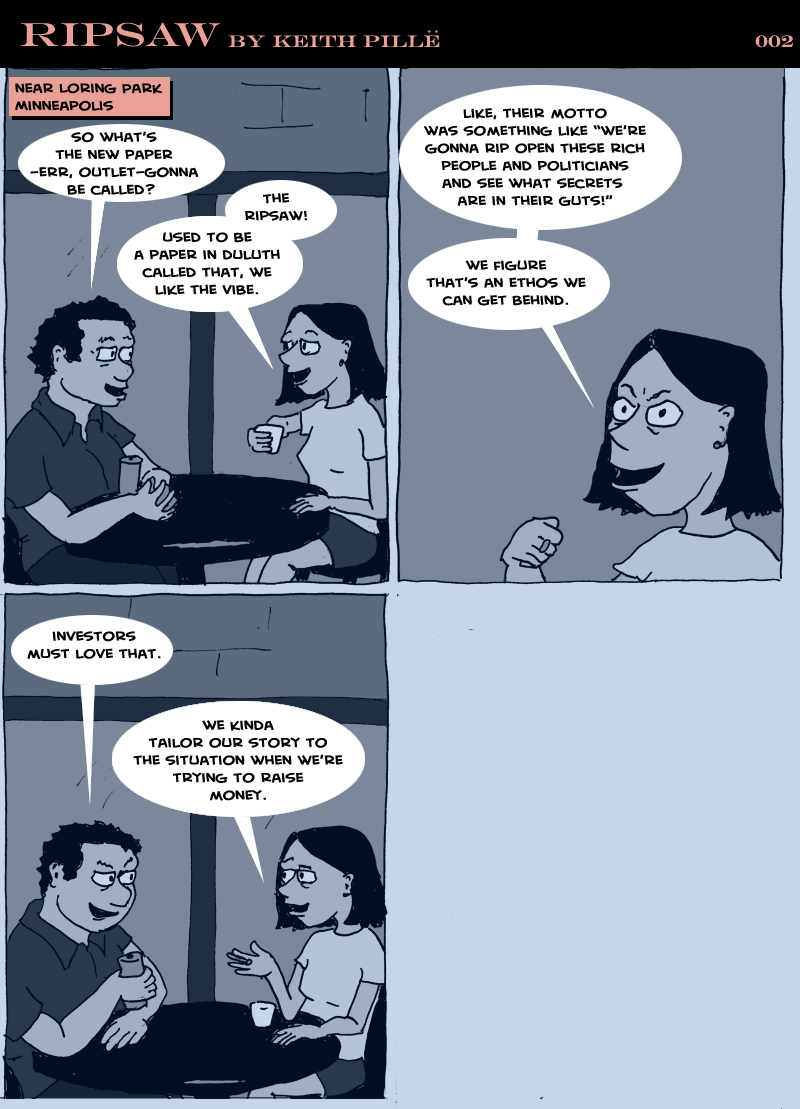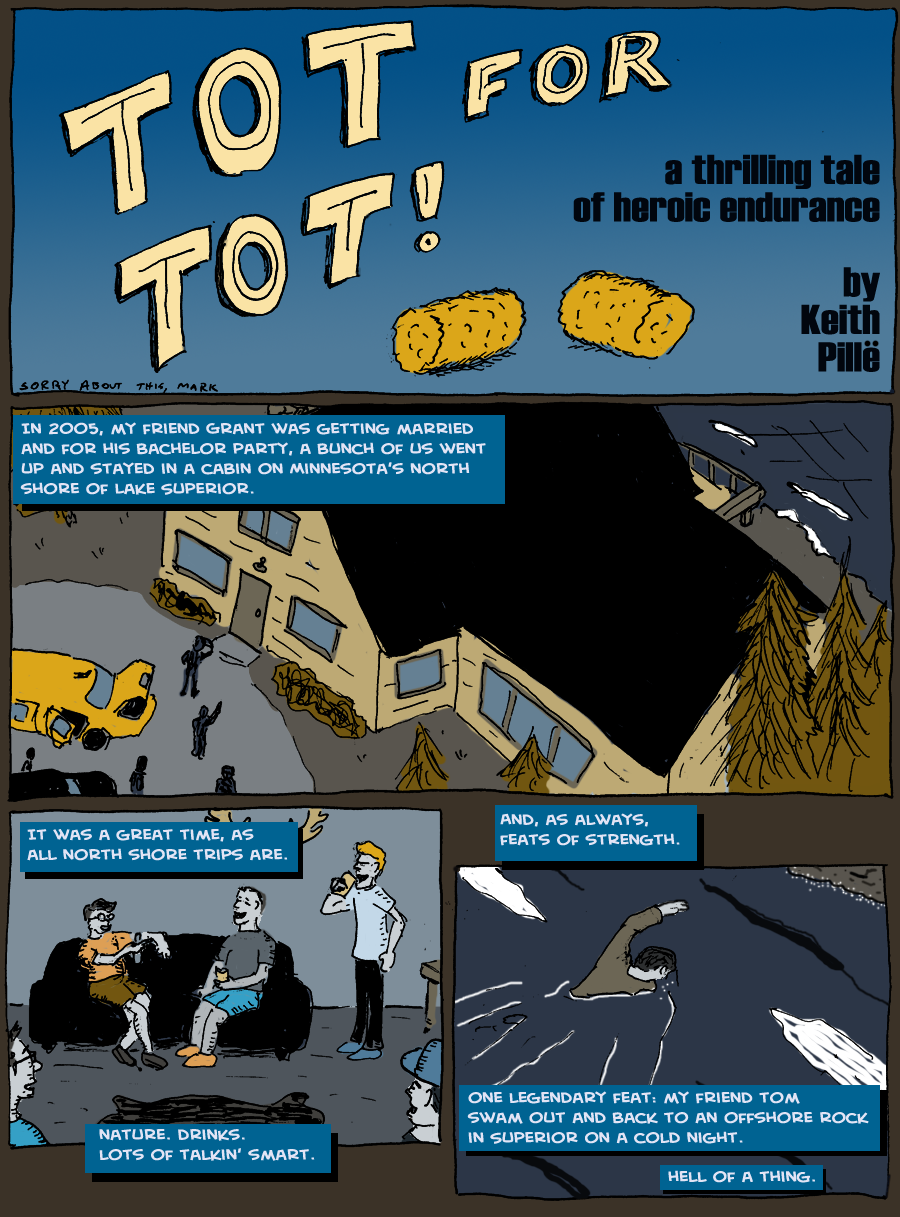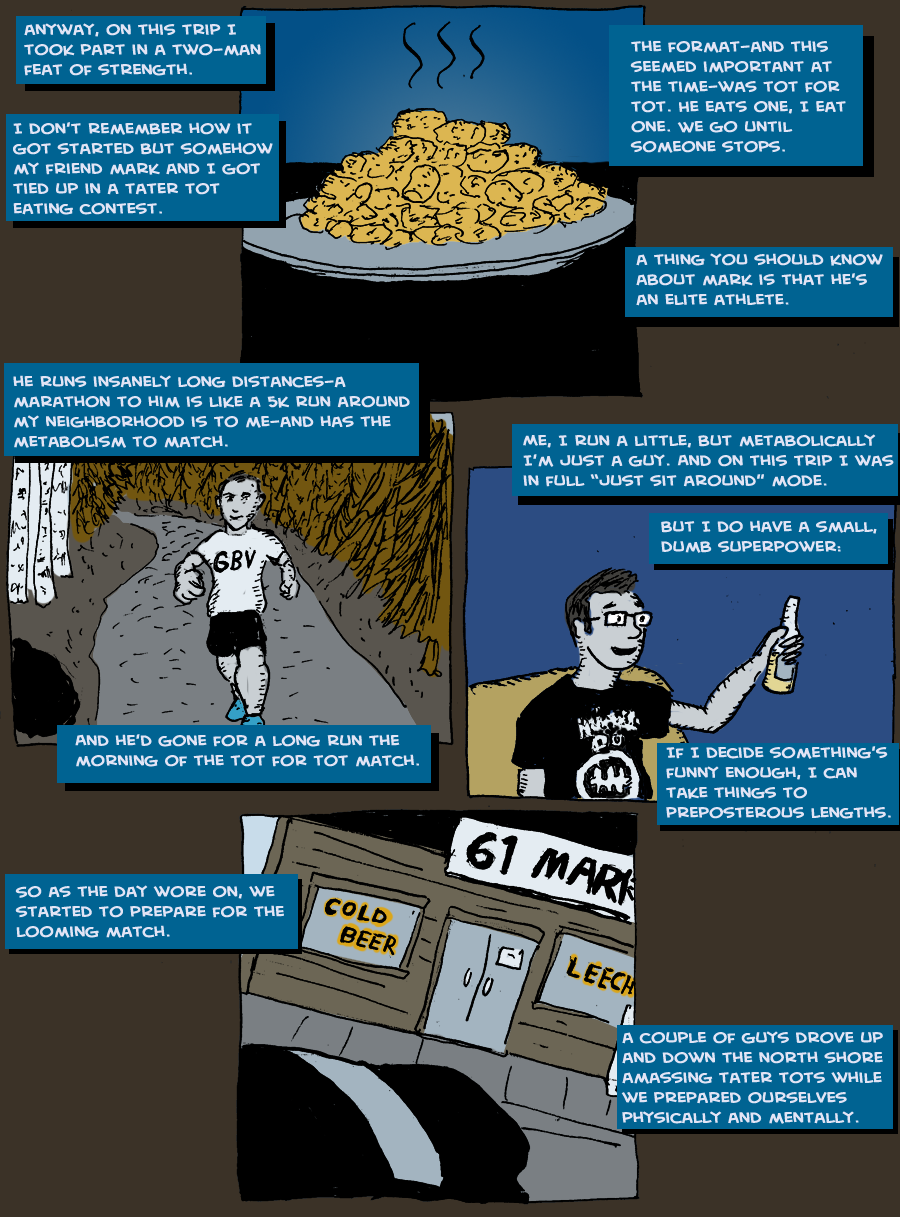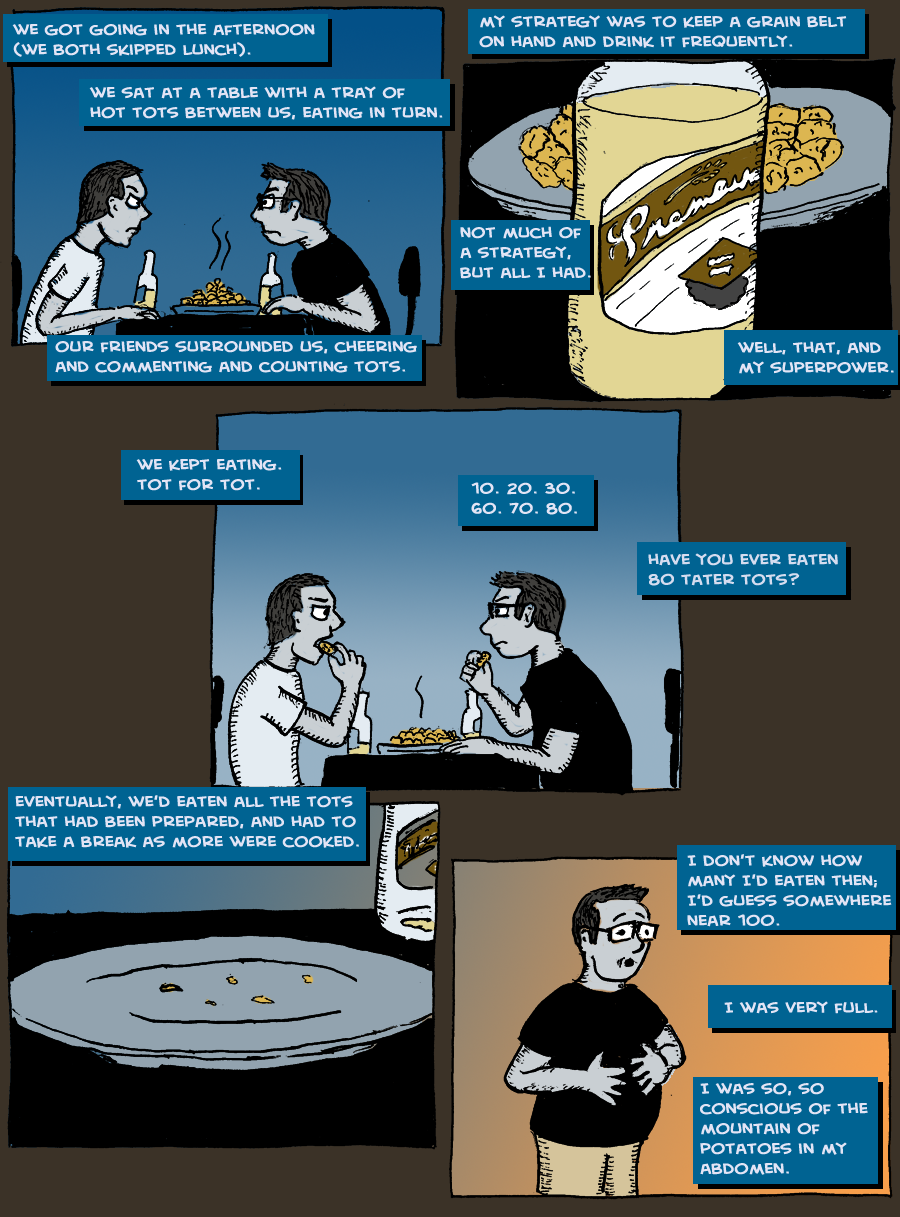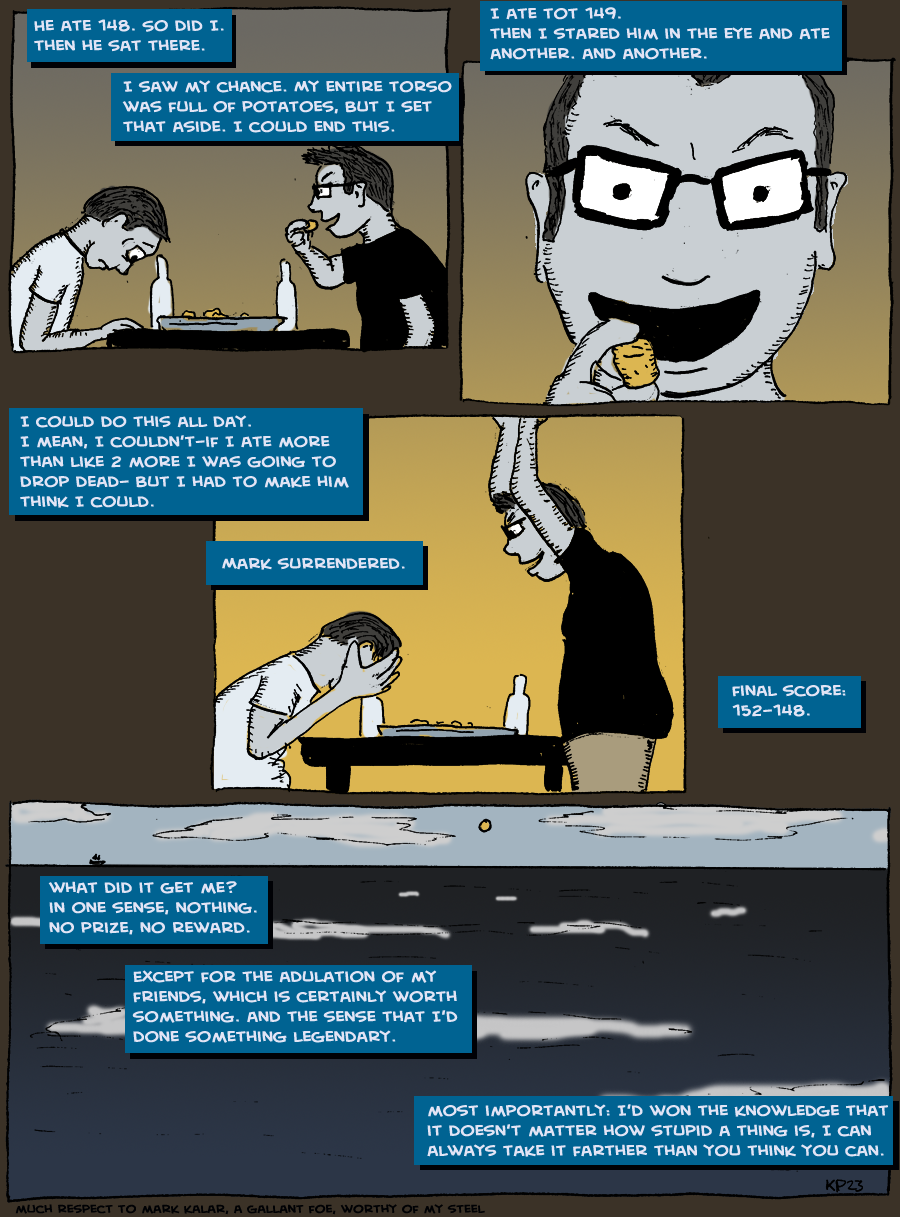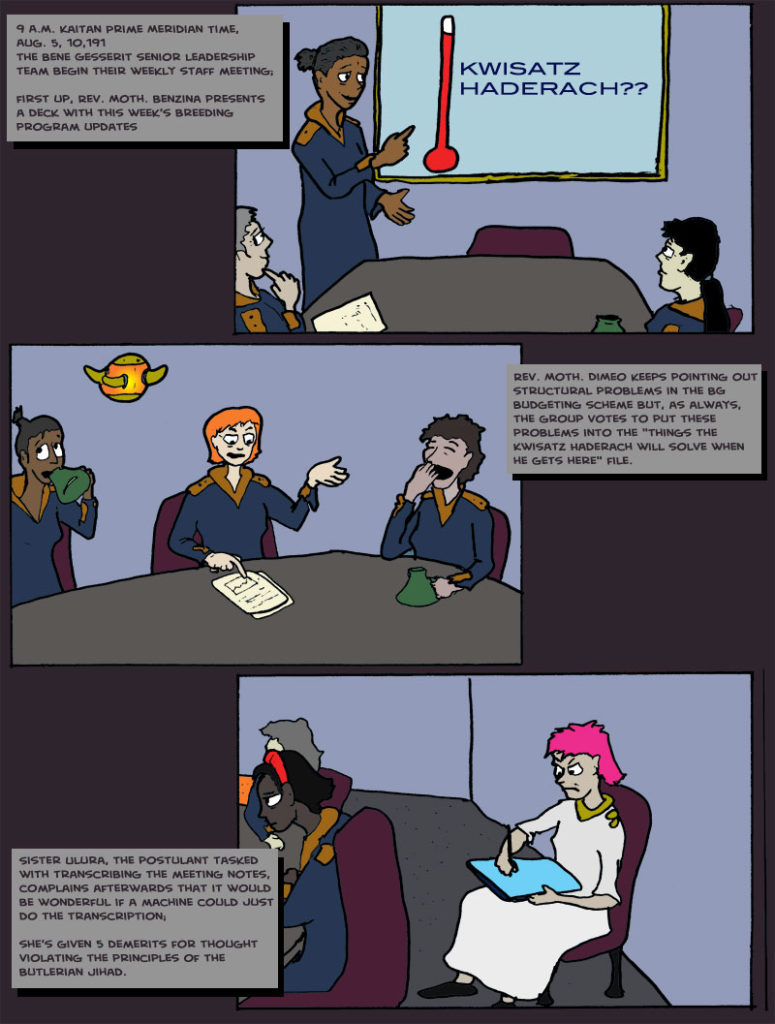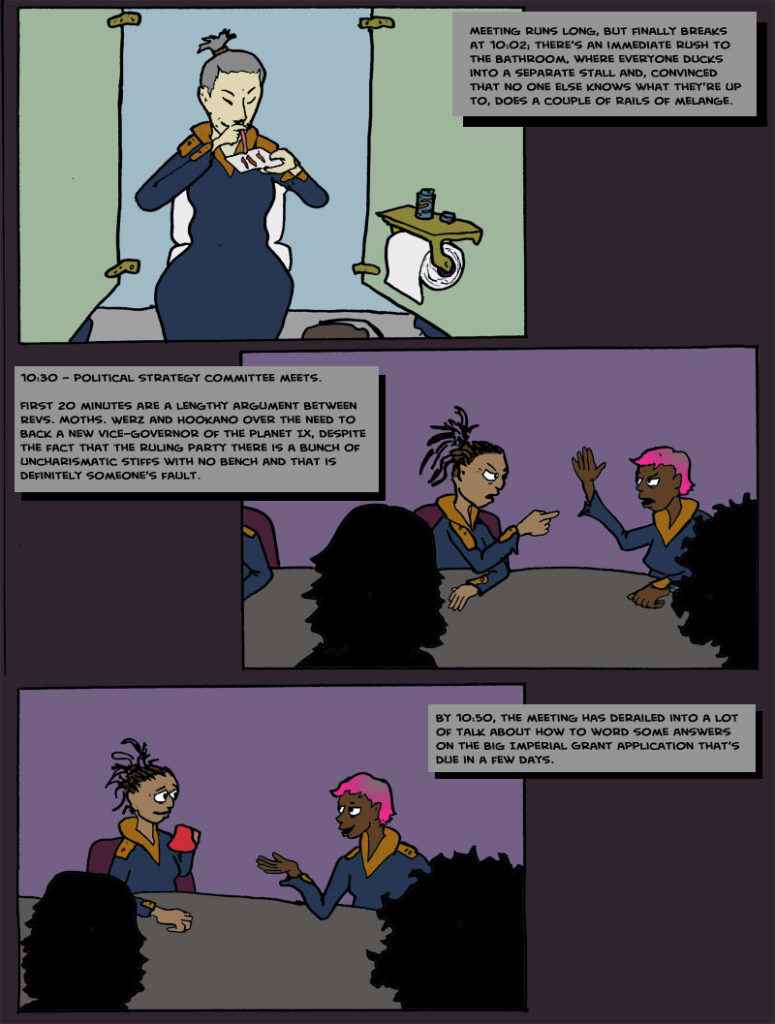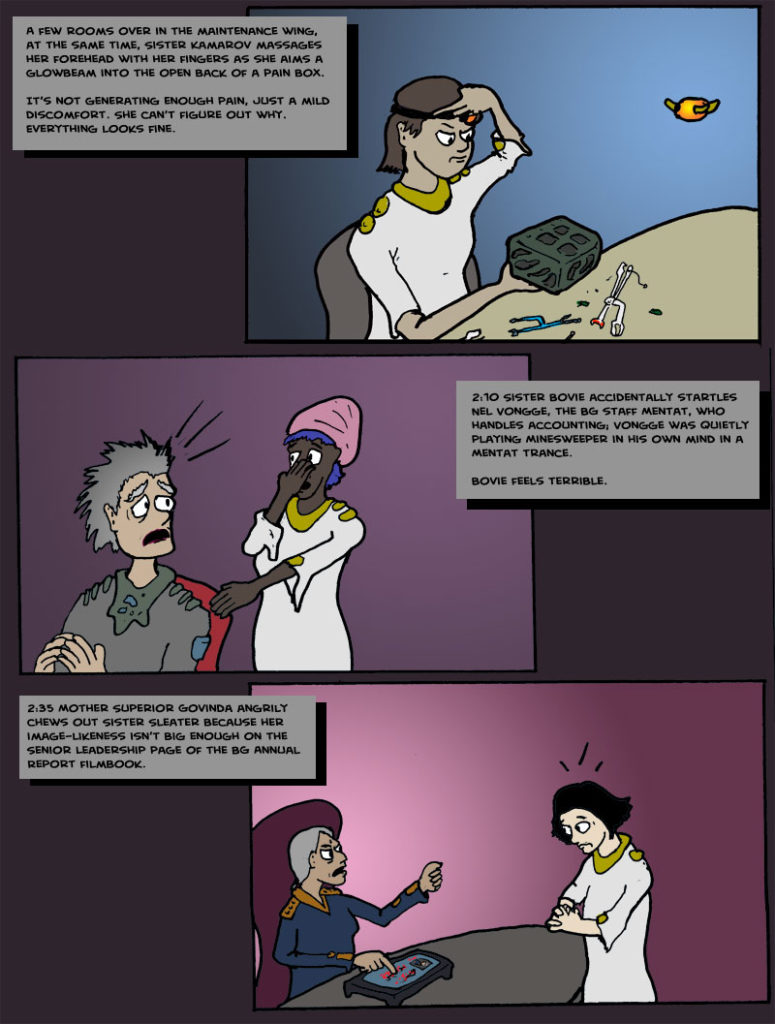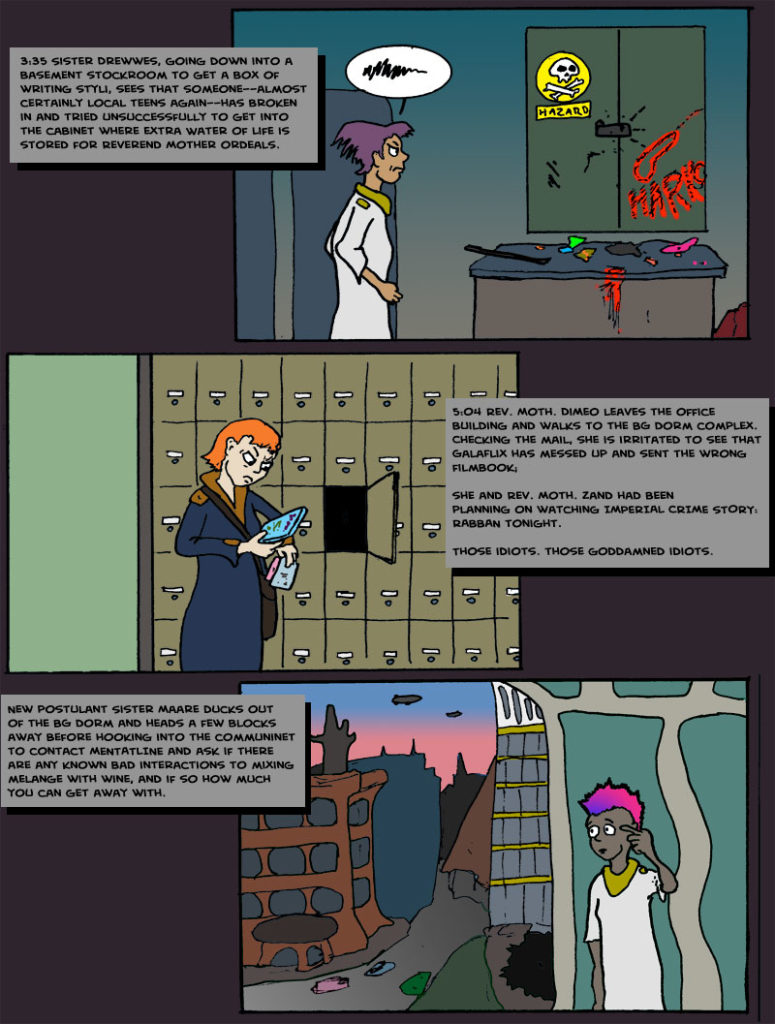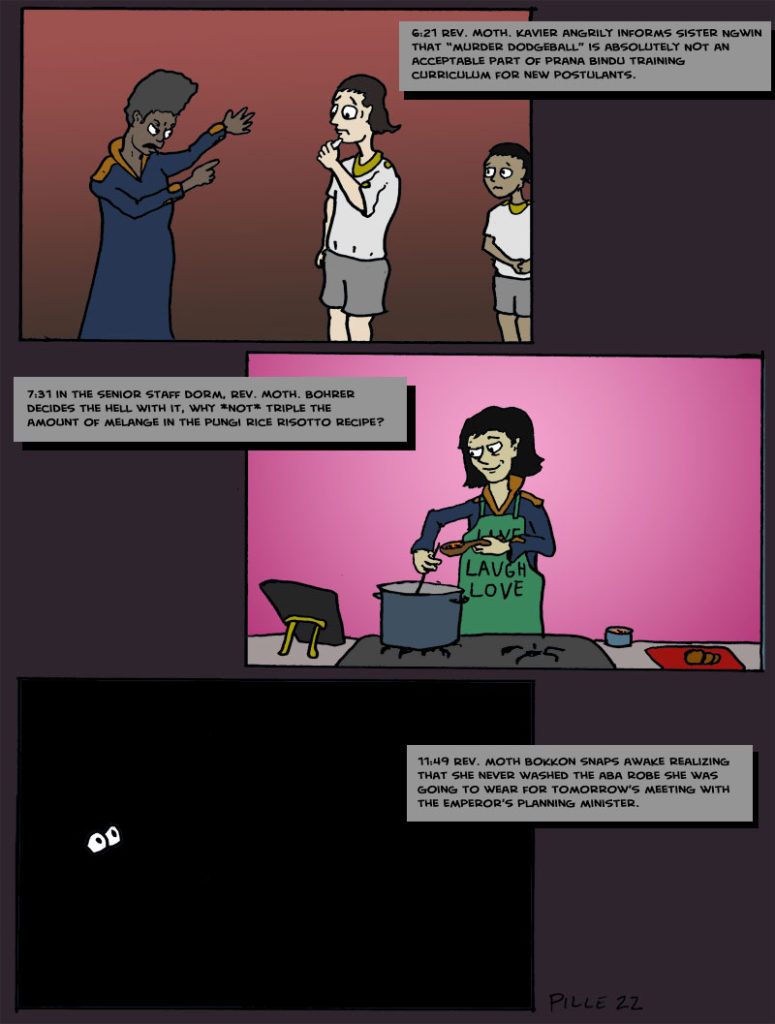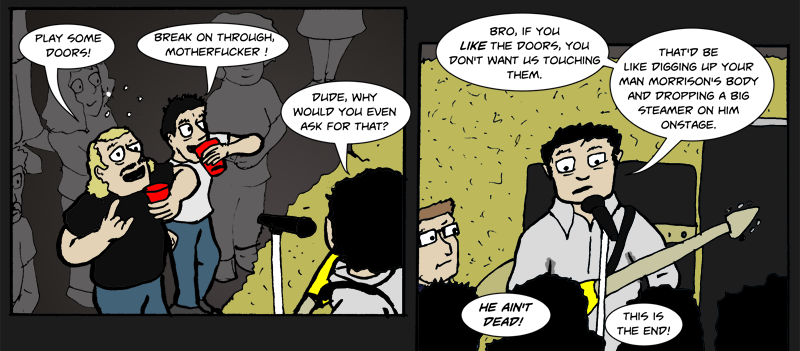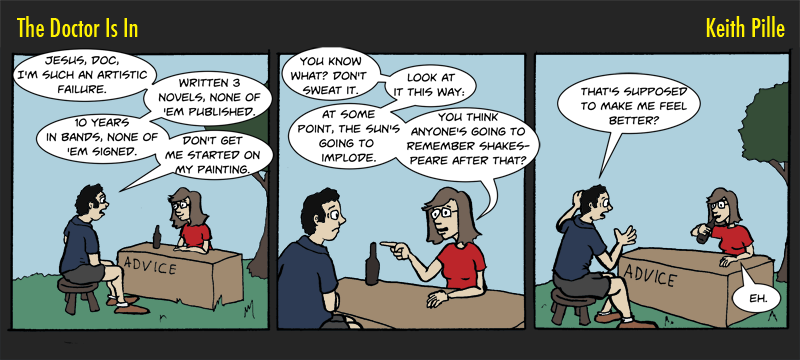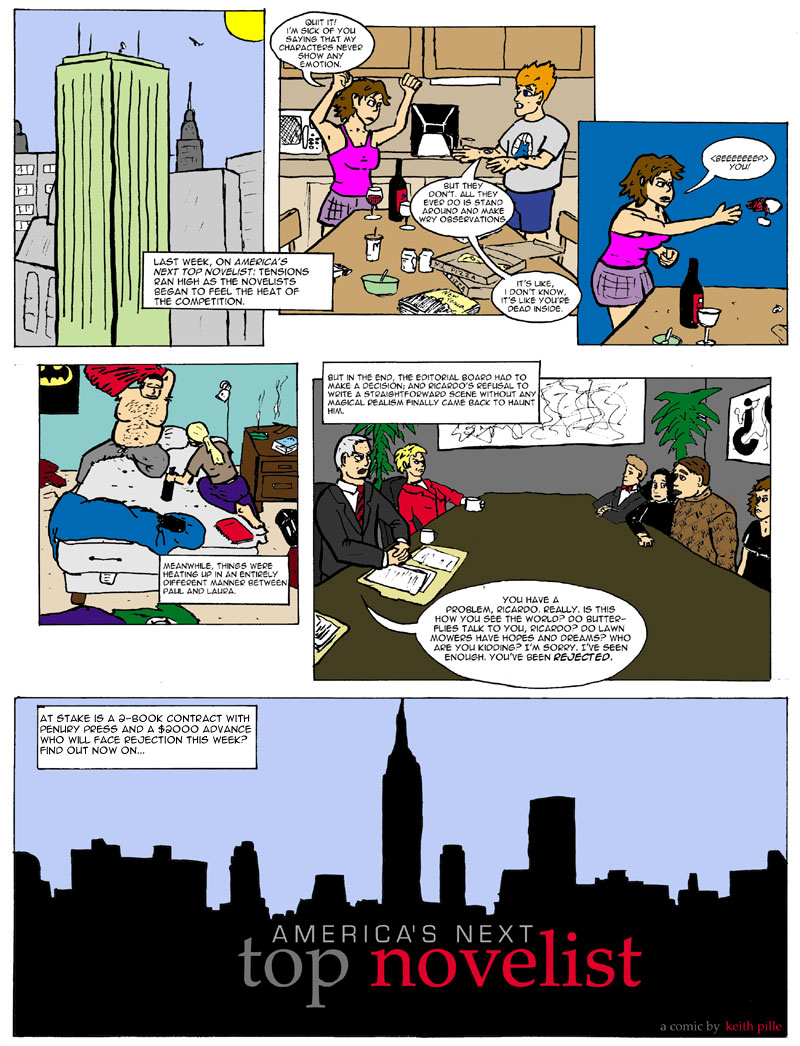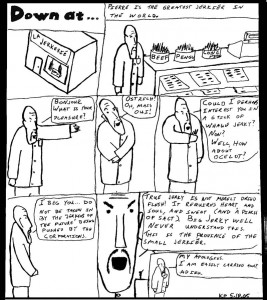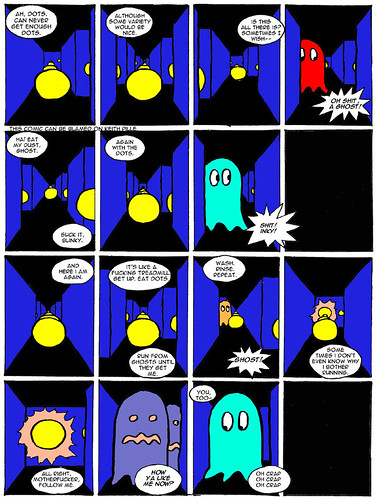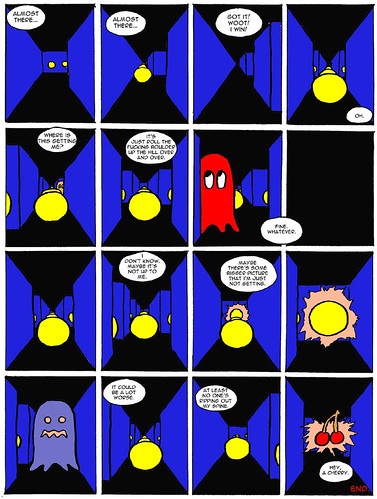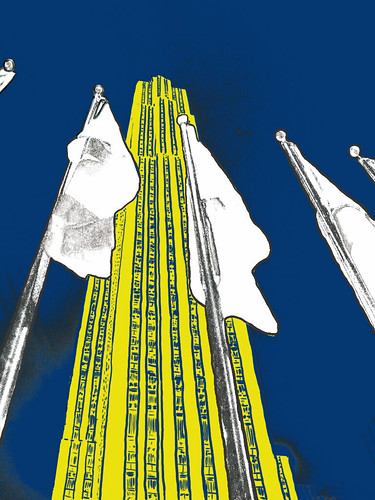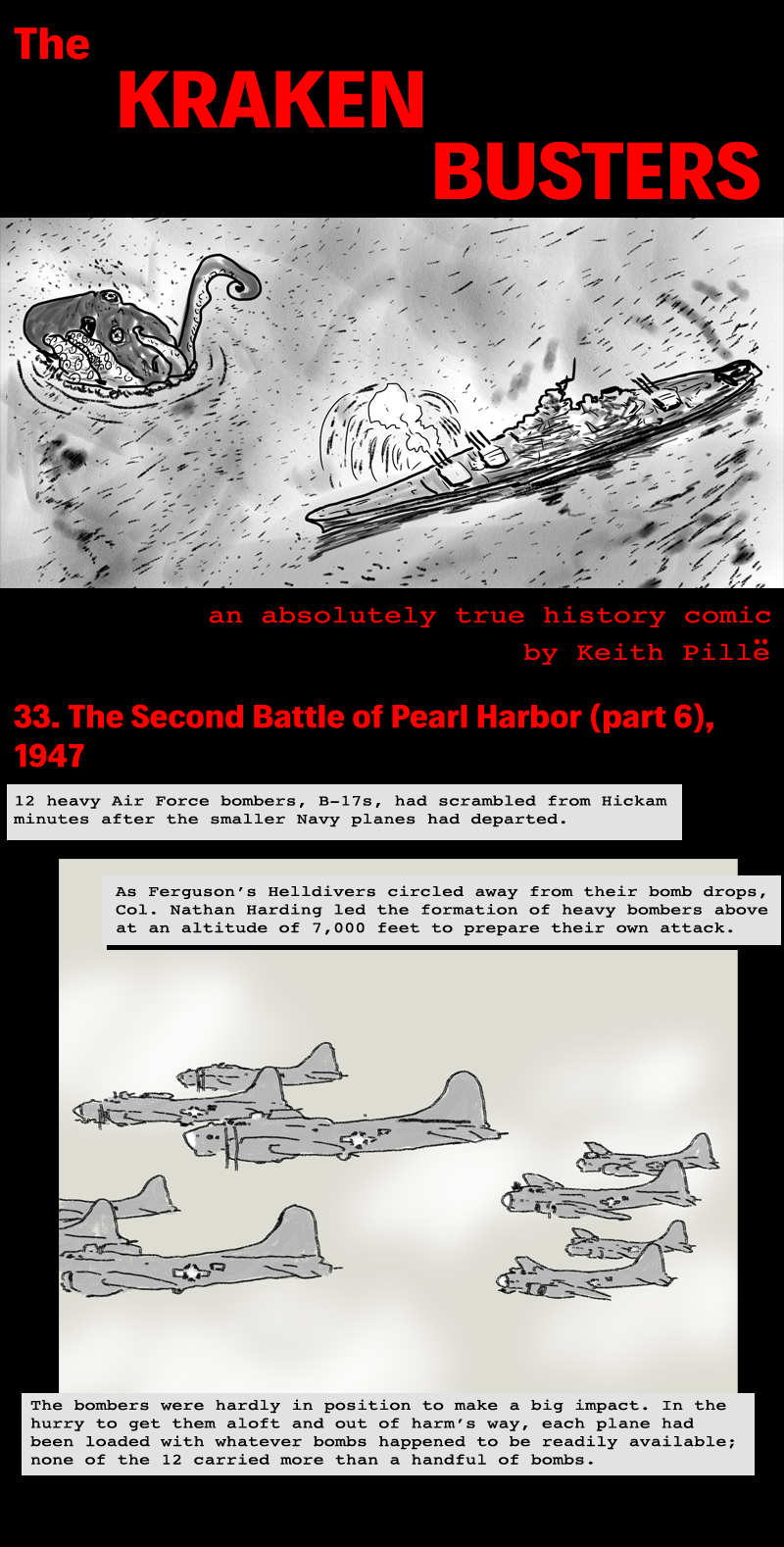
Category Archives: Comics
The Kraken Busters 32
The Kraken Busters 31
The Kraken Busters 30
The Kraken Busters 29
The Kraken Busters 28
The Kraken Busters 27
The Kraken Busters 26
The Kraken Busters 25
The Kraken Busters 24
The Kraken Busters 23
The Kraken Busters 22
The Kraken Busters 21
The Kraken Busters 20
The Kraken Busters 19
The Kraken Busters 18
The Kraken Busters 17
The Kraken Busters 16
The Kraken Busters 15
The Kraken Busters 14
The Kraken Busters 13

Two last quick things! If you’re enjoying these strips, please consider helping to spread the word! Tell a person who might like them, or post on social media, or whatever feels right. And if you really dig the story and have some change rattling around in your pocket, I’ve got a ko-fi set up. No expectations, but hey, support’s always welcome.
The Kraken Busters 12
The Kraken Busters 11
The Kraken Busters 10
The Kraken Busters 09
The Kraken Busters 08
The Kraken Busters 07
The Kraken Busters 06
The Kraken Busters 05
The Kraken Busters 04
The Kraken Busters 03
The Kraken Busters 02
The Kraken Busters- now in (experimental) comic form!
So you’ve probably heard me talk about the book I wrote about the US Navy fighting sea monsters in the 1940s, and then the subsequent podcast adaptation that I did of it. Well, I have a terminal case of Cartoonist Brain, so with a story like that sloshing around in my head, it was inevitable that O’d start getting ideas about different ways that it could be presented visually. And this started to drive me nuts.
And then, inevitably: I sat down to give it a shot. So here is Episode 1 of a notional Kraken Busters comic, trying out some visual ideas and also leaning into some cartooning techniques I’ve never tried before. This might be a one-off, or it might be the start of a massive ongoing project to adapt the whole thing; if you dig it, please let me know, because that could help determine which way this goes (same thing, I guess, if you really think it sucks!).
| Next >

Ripsaw 037
Ripsaw 036
Ripsaw 035
Ripsaw 034
Pickup Switch #8
Pickup Switch #7
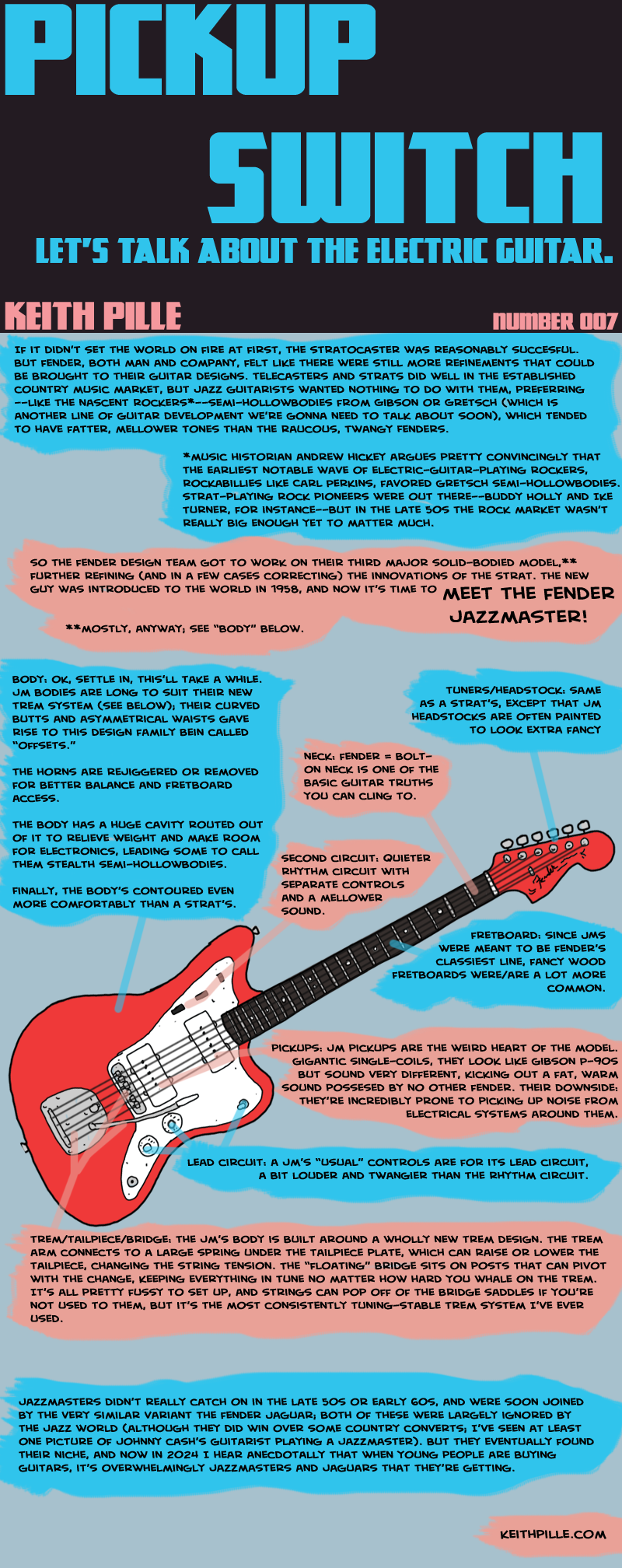
<< FIRST STRIP | < PREVIOUS | NEXT STRIP >
I should add that this run of “meet the…” strips detailing the iterative designs of the 50s and 60s is almost done! One more, and then it should be on to more general-purpose guitar-talkin’.
Pickup Switch #6
Pickup Switch #5
Pickup Switch #4
Ripsaw 033
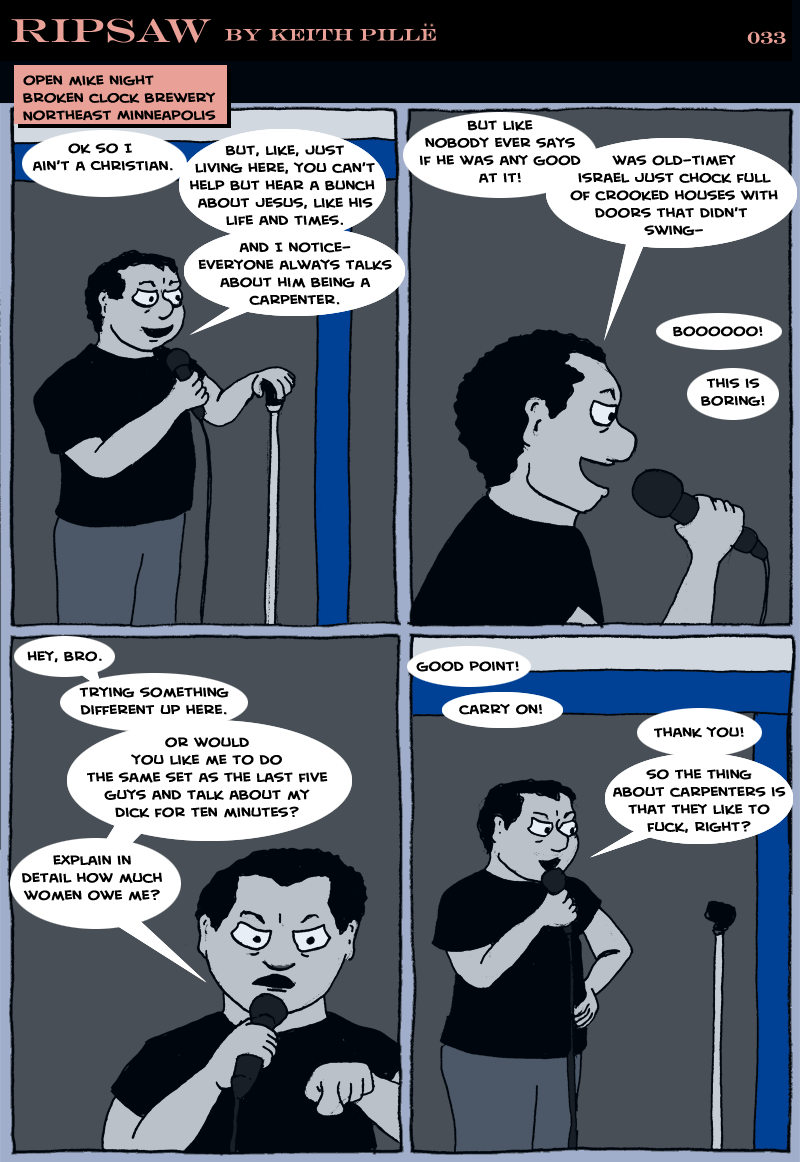
<< FIRST STRIP | < PREVIOUS | NEXT STRIP >
Maybe worth noting that I kind of have a 3-way creative split going on right now between Ripsaw, Pickup Switch, and A Life in Film (4-way if you include the band, I guess), so progress on all of them might be a little slow, especially for the next couple of weeks as I settle into a new job. I know you’re supposed to just pick one thing and be good at it, but that’s not how my brain works.
Just know that nothing’s being abandoned, it’s all just moving along at its own pace. And thanks!
Pickup Switch #3
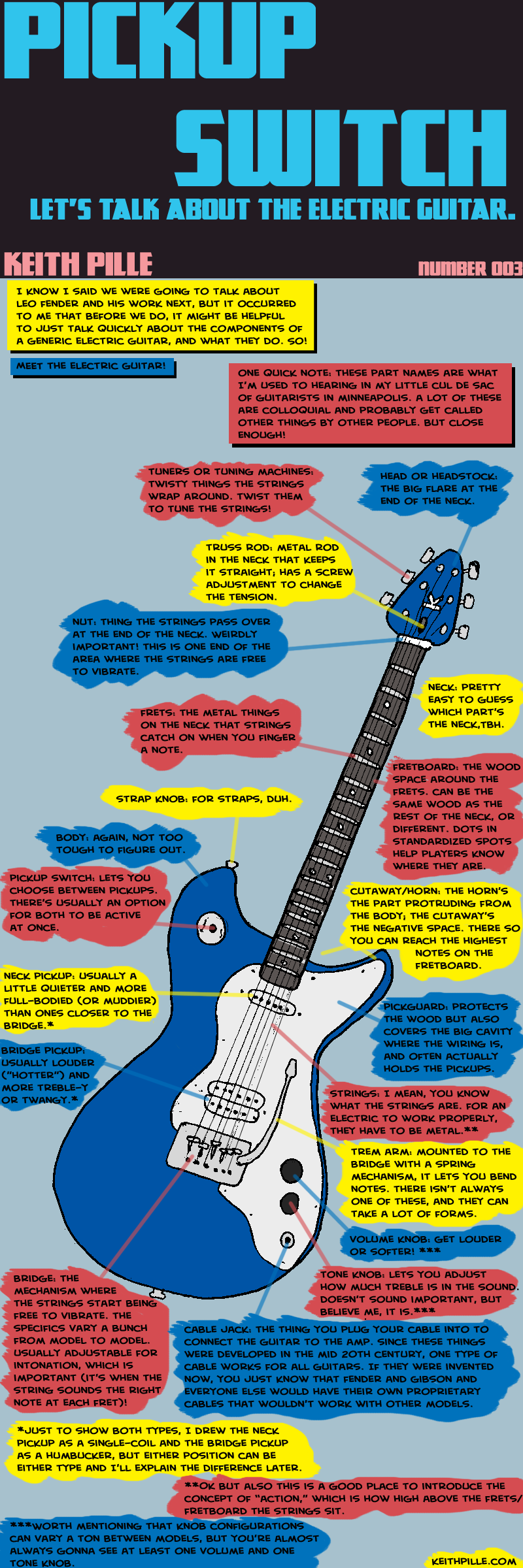
<< FIRST STRIP | < PREVIOUS | NEXT STRIP >
This is–by a wide margin–the most words I have ever put into any comic.
Pickup Switch #2
Pickup Switch #1
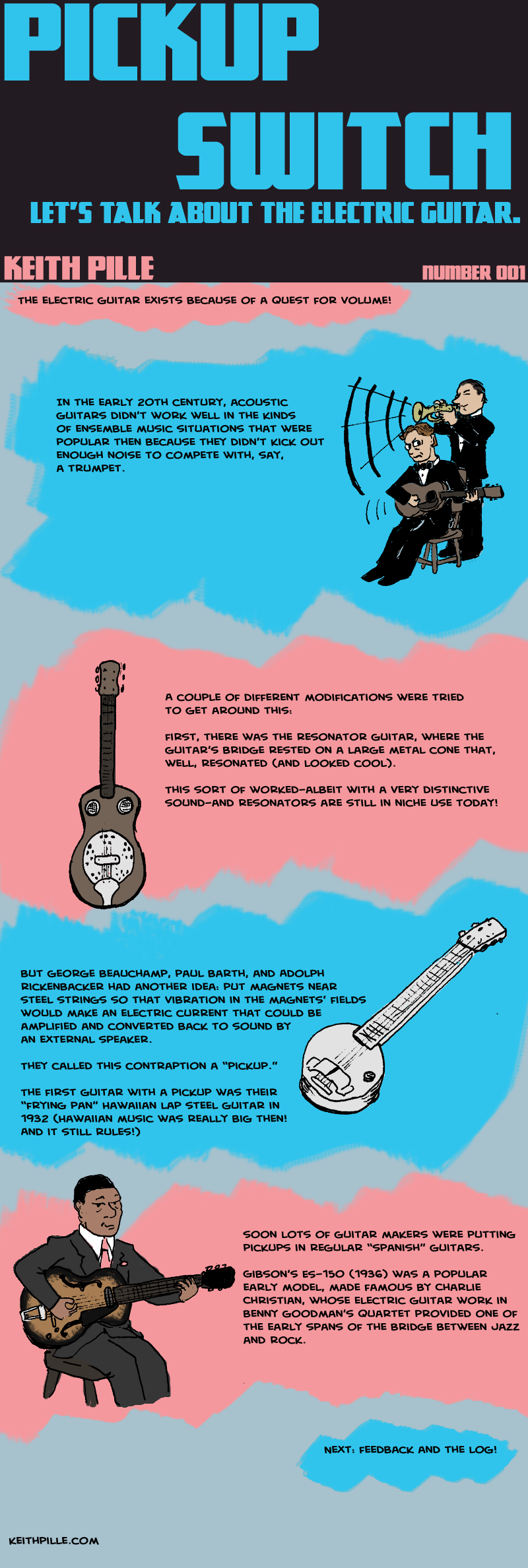
OK! Here’s the next thing I’m trying!
If you follow me on Bluesky (or used to follow me on Twitter), you know I have a bazillion opinions on electric guitars. So I thought it might be fun and interesting to try a nonfiction comic about ’em. I’ll be looking at the history, design, and function of electric guitars.
Does this mean that Ripsaw’s done? Nope! That was always gonna be a strip that would run for a while and then sleep for a while; so this is a thing that will happen during Ripsaw naps. And vice versa.
Ripsaw 032
Ripsaw 031
Ripsaw 030
Ripsaw 029
Ripsaw 028
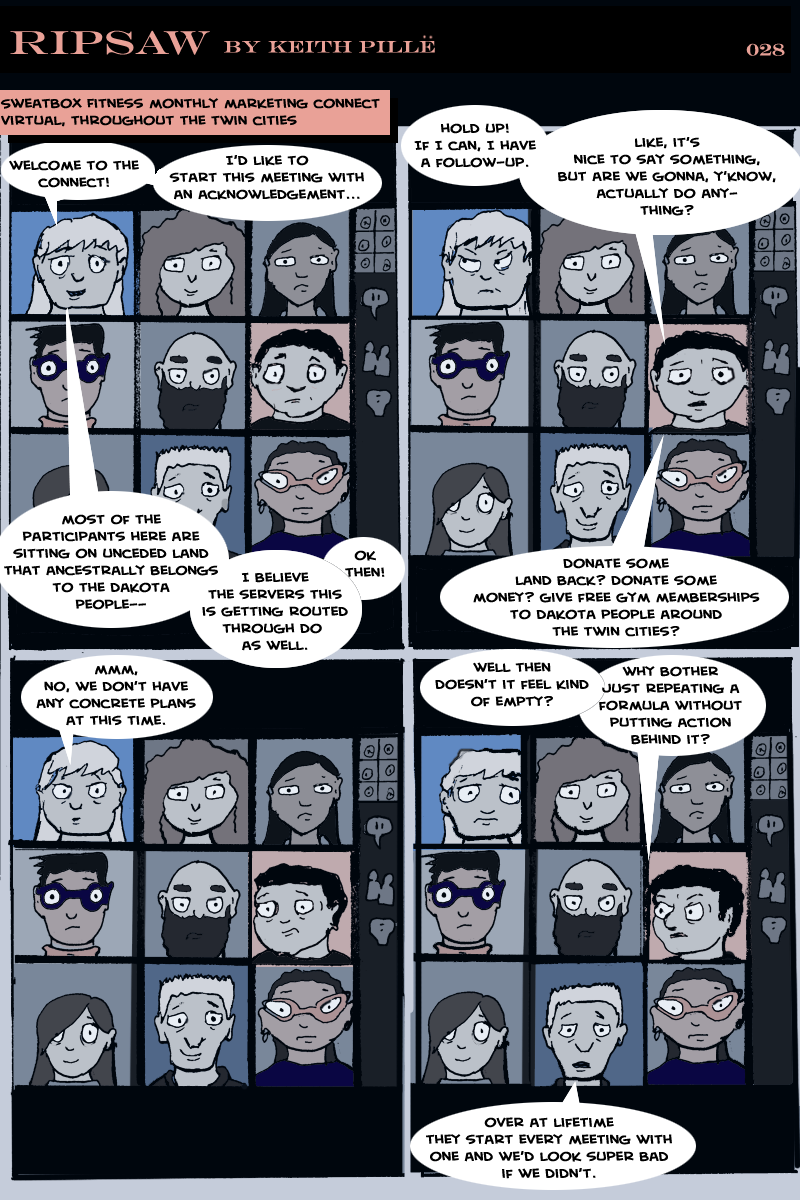
<< FIRST STRIP | < PREVIOUS | NEXT STRIP >
To be super-duper ultra-mega clear: I think it’s great when Americans of Euro descent are conscious of the history of the land they’re on, and what had to happen for things to be the way they are. I’ve seen land acknowledgements done as part of larger holistic programs , and I think that’s great when I see it. My beef is entirely with words divorced from action. I’m not calling for fewer land acknowledgments here, I’m calling for more action to go with them.
Ripsaw 027
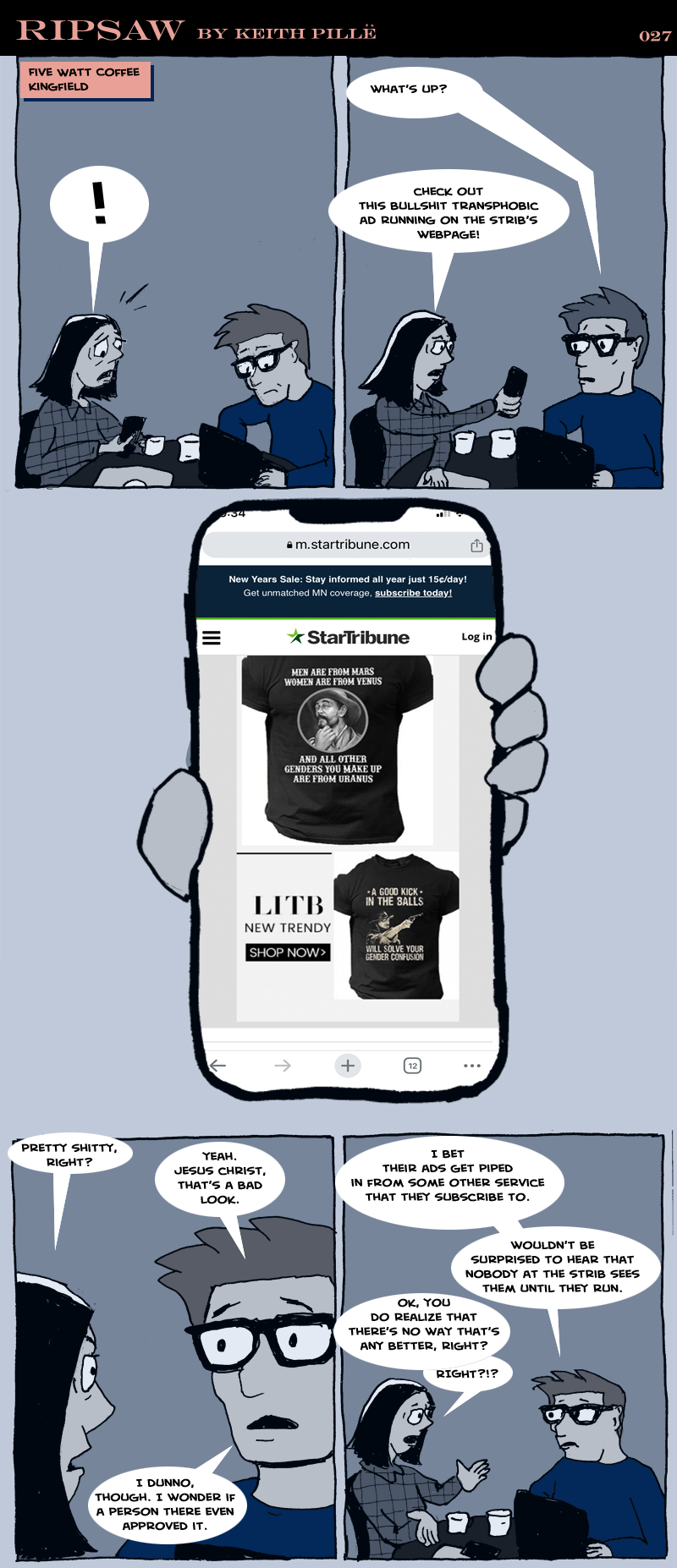
<< FIRST STRIP | < PREVIOUS | NEXT STRIP >
Quick explanatory note on this one: this is a real screenshot from the Strib on 1/1/24. I was and am pretty appalled.
Ripsaw 026
Ripsaw 025
Ripsaw 024
Ripsaw 023
THE UNEXPECTED FINAL BUMMER OF THE IOWA CITY POLICE LOG
So, from January of 2020 to September of 2023 (with a couple of breaks), I had a project where I’d look at the twitter feed of the Iowa City Police Log, pick an entry for the day, and draw a single-panel cartoon based on it. It was a lot of fun! Of all the art projects I’ve done in my life, it was one that resonated the most with other people; Twin Cities Public Television did a piece on it, and I wound up meeting a bunch of fun and cool people online through the strip. All of the strips are still available on Instagram (twitter, too, but IG’s the better interface), and I remain proud and full of love for them.
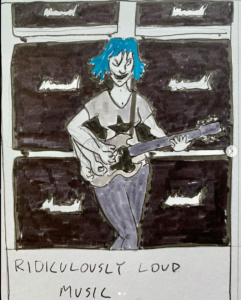
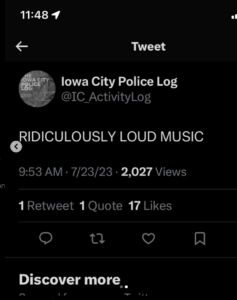
I wound it down in September of ’23 for a bunch of intertwining reasons: the strip was tightly tied to Twitter, and at that point (and I guess still) it wasn’t clear how much longer Twitter would be around, or how cool it was to be involved with it given Musk’s determination to remake the site into a right-wing oasis; I was getting worried that, after about 620 strips, I was running out of jokes and in danger of repeating myself; and, as those snowballs rolled down the mountain of my brain and started to get bigger, internal political stuff in Iowa City forced the issue when the city changed the way it reported police incidents, kneecapping the feed I depended on. So my choice was made for me. The police log strip was done after a long and full life, and it was time to move on to other projects.
Continue reading THE UNEXPECTED FINAL BUMMER OF THE IOWA CITY POLICE LOGRipsaw 022
Ripsaw 021
Ripsaw 020
Ripsaw 019
Ripsaw 018
Ripsaw 017
Ripsaw 016
Ripsaw 015
Ripsaw 014
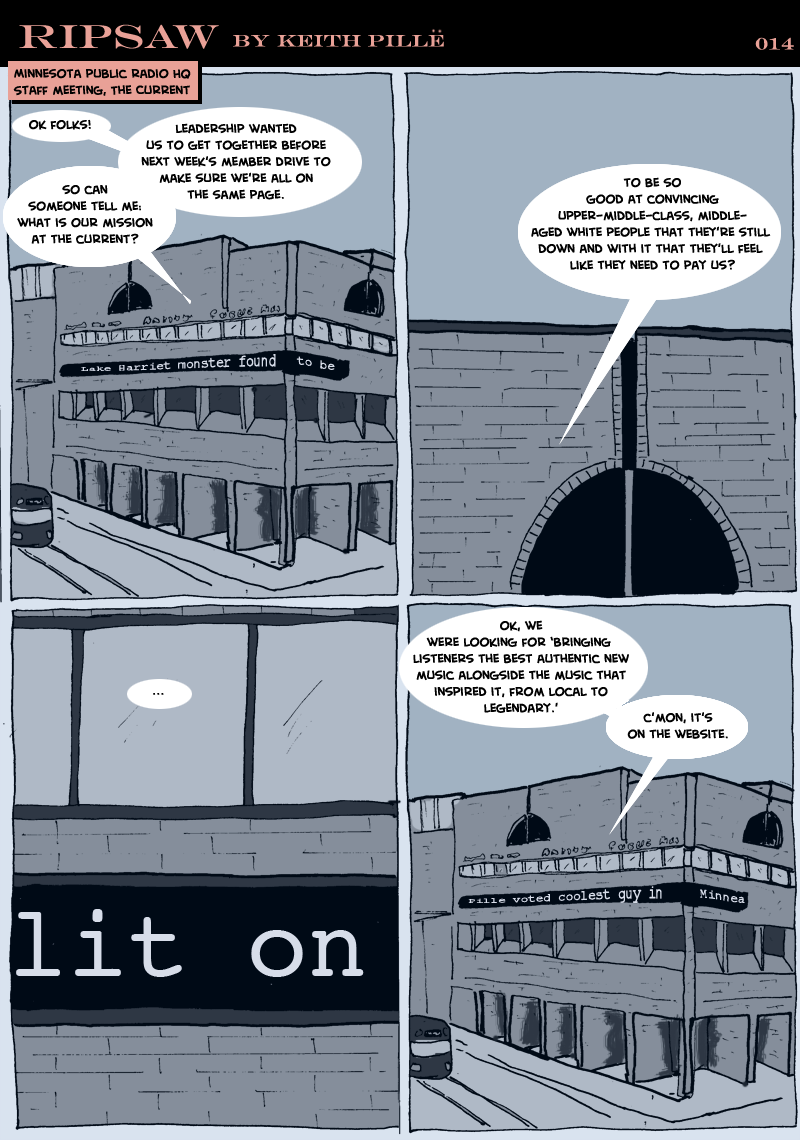
OK, to be clear: this is coming from a place of skeptical love. I like the Current a lot, they’re a community asset, and they’re the only rock station in town worth paying attention to enough to joke about. But I really can’t shake the feeling that the main thing they provide is a sense to old musicheads that they won’t get made to look out-of-touch when they talk to people in their 20s.
Ripsaw 013
Ripsaw 012
Ripsaw 011
Ripsaw 010
Ripsaw 009
Ripsaw 008
Ripsaw 007
Ripsaw 006
Ripsaw 005
Ripsaw 004
Ripsaw 003
Ripsaw 002
Ripsaw 001
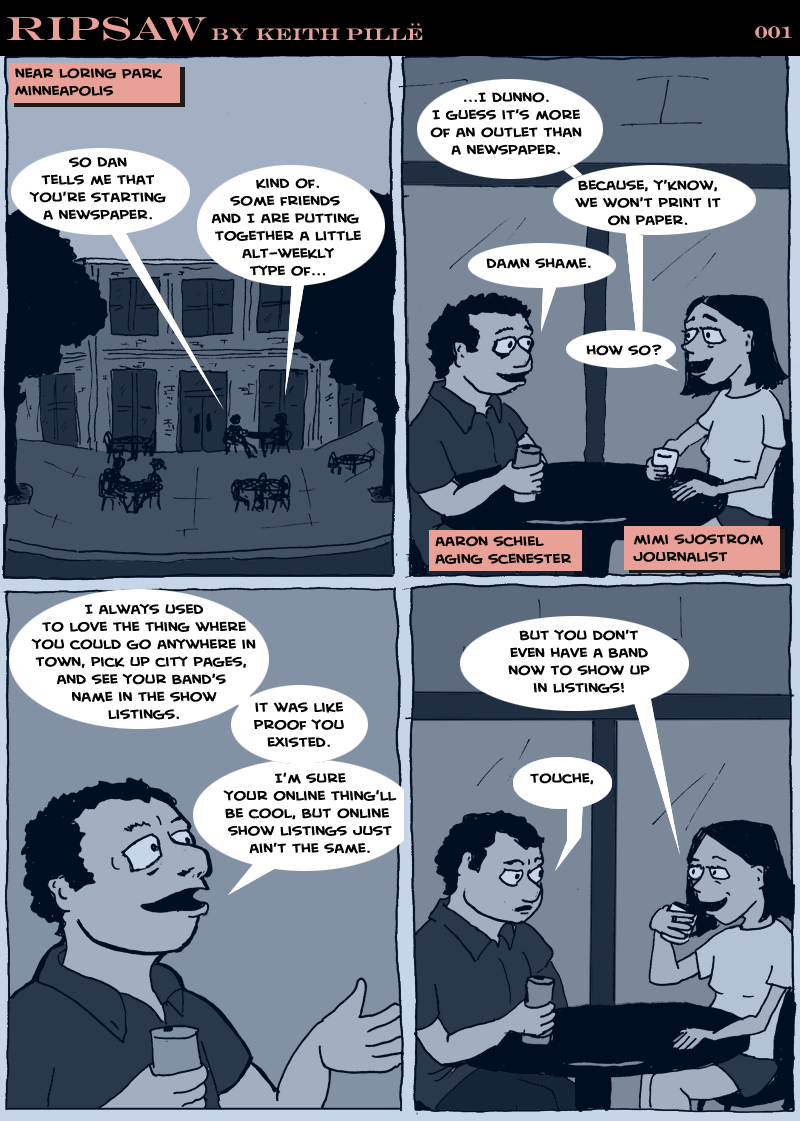
Holy shit! A brand new webcomic era begins! You might recognize these two characters from Nowhere Band; don’t worry, you don’t need to read back issues to get what they’re up to, and there are plenty of new characters coming.
Tot for Tot
Monday at Bene Gesserit HQ
Digging into Achewood
Quick note: this originally ran as two separate-but-related articles at the late, lamented Comics MNT. Alas, nothing is permanent on the internet; but I like these pieces too much to let them succumb to link rot. So here they are, together at last!
1. The Complicated, Slightly Better Manhood of Achewood
Remember Chris Onstad’s Achewood? If you care enough about comics to be reading the MNT and were online between 2000 and 2010, you must. For most of the first decade of this century, Achewood was one of the flagship webcomics when webcomics were an exciting new cultural space; it might not have had the reader numbers of some of the topical gamer strips, but its cultural presence was huge and it was very much the critical darling of the scene.
If you need a refresher: Achewood was a weirdly erudite, often filthy, funny-animal strip with minimalist Charles-Schulz-with-Adobe-Illustrator black and white art and aggressively unconventional lettering (almost certainly the only landmark comic to be lettered in the Chicago font). The cast was distinctive; the strip centered on Ray Smuckles, an oblivious but goodhearted thong-wearing rap mogul cat, and his depressed computer-programmer friend Roast Beef Kazenzakis. Other major characters included an avuncular novelist bear, another bear who loves food and The Cure, an eternally childish, bottomlessly naive otter, a couple of eastern European robots, and several others. And yes, all of these listed characters are male, and yes, that will become important later.
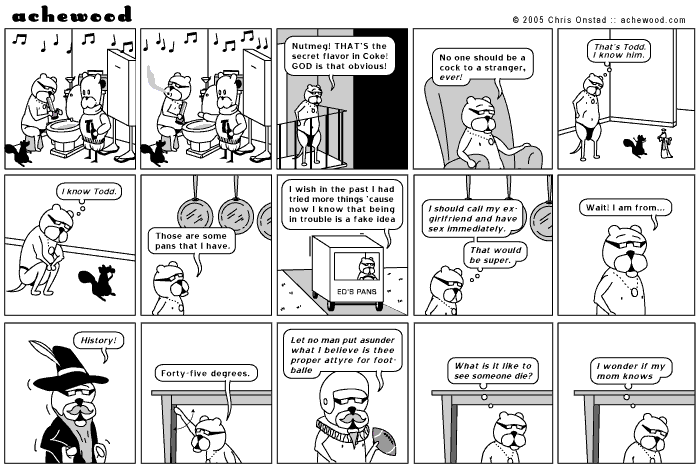
The Iowa City Police Log
Quick update from December of 2023: the Police Log comics are now a finished project, with an unfortunate coda. I’m still proud of the comics, though, and they’re still available as linked. If you see anything involving the Iowa City Police Log and AI art, please know that I had nothing to do with it.

Every morning, I get up, consult the twitter feed of the Iowa City Police Log, and draw a one-panel cartoon based on it. This started out as a get-through-the-winter whim and has turned into a get-through-a-pandemic-hellscape coping mechanism. The resulting comics get posted to a Twitter thread and to my Instagram feed, in both cases paired with their inciting Police Log entry.
People seem to be pretty into these, which is great! TPT, Minnesota’s Public Television station, even did a short piece on them, where I talk about my process, my motivations, and the sort-of-intentional larger political point of the strips in an era where we as a society are rethinking the way police departments should be constituted. They also put KEITH PILLE – CARTOONIST on the screen, so I guess despite endless questions about my artistic identity, now I know: I’m a cartoonist.
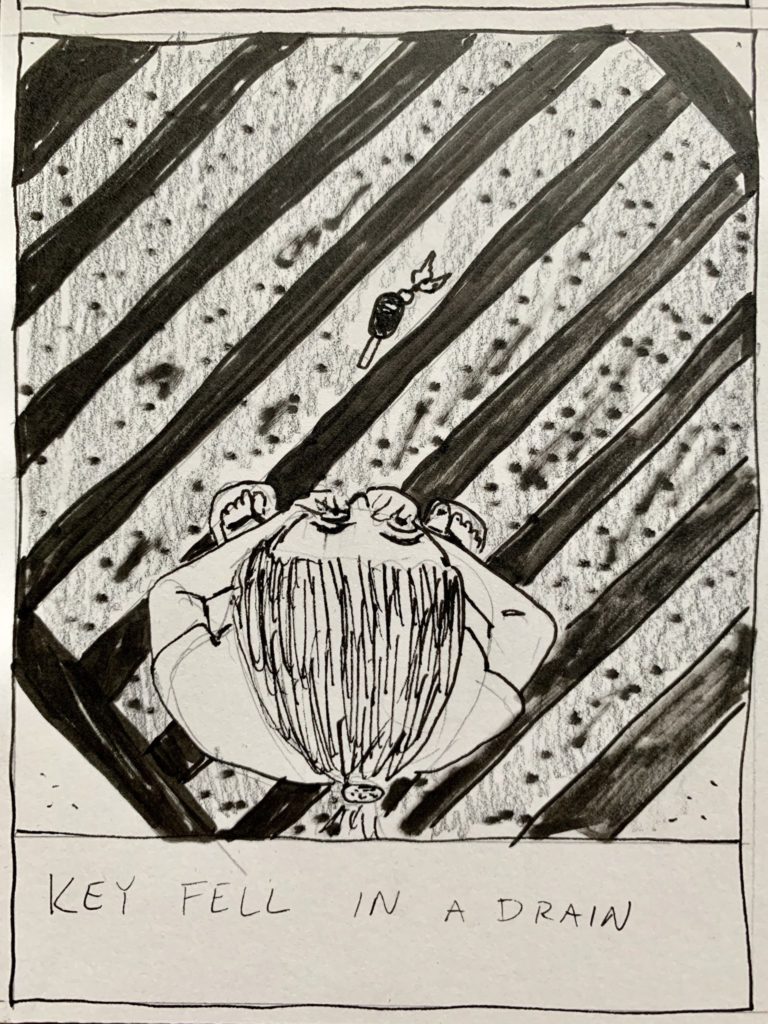
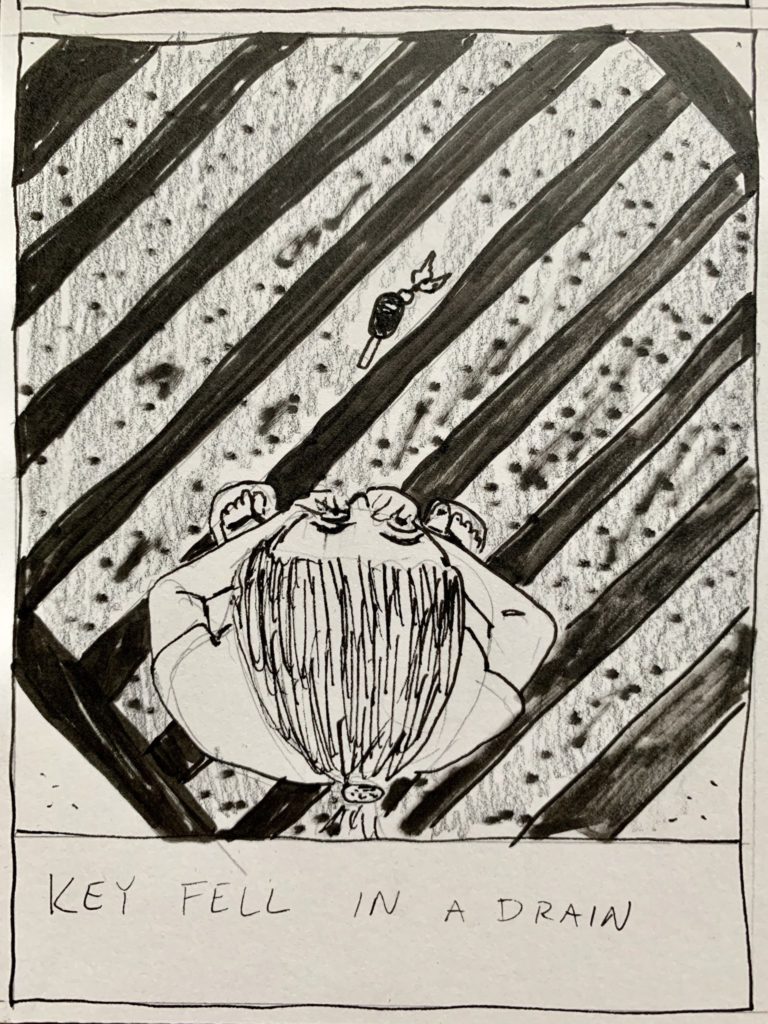
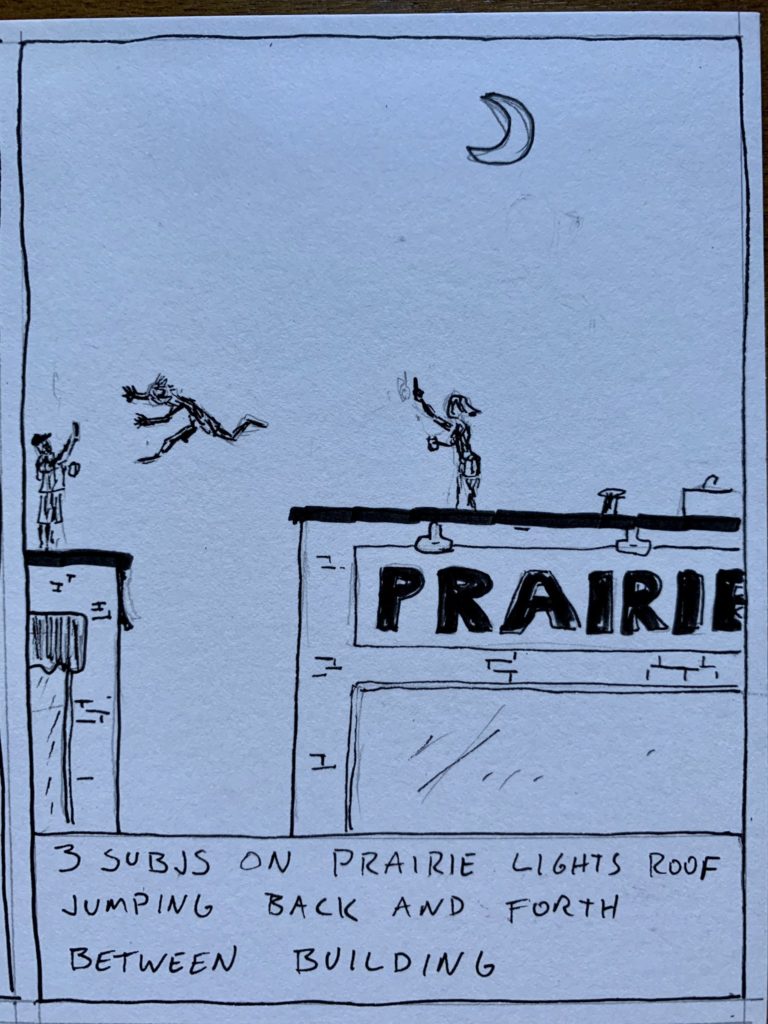
The Nowhere Band Restoration Project
So for ten years, from 2007-2017, I made a webcomic called Nowhere Band that was about life as it’s really lived in a music scene: a series of misadventures that are great and fun and affirming and frustrating and maddening and which, ultimately, don’t end with fame and fortune. I wanted it to be as emotionally real as possible. I always felt like I did a pretty good job with that, and got some outside validation on that front, both from individual readers (who I always loved hearing from) and from Minneapolis media outlets like MPR News and City Pages.
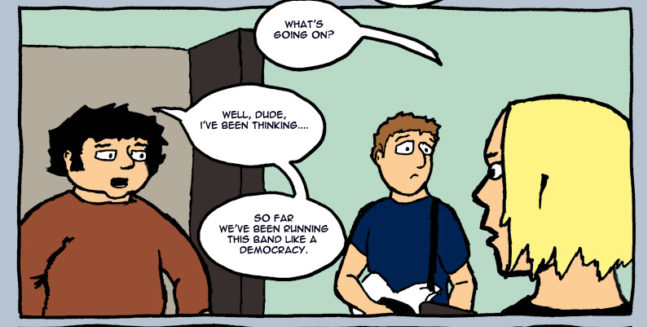
As the years went on (and the art and general cartooning craft got better), the strip moved from being about people in a band to being about people who used to be in a band and maybe kind of still were but weren’t sure. Which I think is also a headspace worth exploring, since that’s where we all wind up! But in 2017, after several hundred installments, I ended the strip because 1) I was far enough removed from band activity at that point that I felt like I was running out of material, 2) I was getting ready to finish grad school and knew that my thesis project was going to eat up all possible cartooning time, and 3) since November of 2016, the strip had increasingly just been swallowed by the dread of living in Trump’s America. So I gave myself the gift of writing the strip towards a conscious, planned ending instead of just letting it peter out the way a lot of webcomics do (and the way it nearly had a couple of times previously).
Continue reading The Nowhere Band Restoration ProjectFRANKLIN, CHARLES SCHULZ’S ACCIDENTAL TOKEN
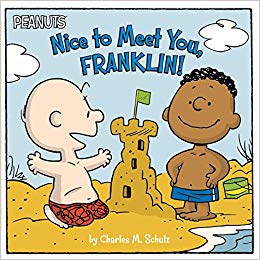
It always hurts to talk about when one of your heroes fails, but that’s what I’m out to do here. Charles Schulz is one of the great figures in comics; Charles Schulz sometimes fell on his ass. He did here. Acting with well-documented good intentions, he tried to do a good thing, and slid into what could most charitably be called mixed success. By introducing Franklin, a black character, into his immensely popular comic strip Peanuts, Charles Schulz wanted to harness his cultural power and use it to send a positive social message about racial harmony. He explicitly wanted to integrate his strip in a way that wasn’t demeaning or insulting. Thirty years later, though, Franklin was considered one of the prime exemplars of tokenism, a perception that has only grown as time has continued to pass.
Peanuts in 1968 was a cultural juggernaut, appearing in well over 2500 newspapers. In an era when newspaper comics carried a cultural weight nearly unimaginable today, Schulz was at the very top of the profession, giving him one of the most visible platforms in the country to trumpet any message he chose.
For the most part, Schulz avoided politics in the strip, instead examining emotional and existential humor.

Devil Track Lake
KP|CIA
And here’s my first stab at a new direction after Nowhere Band. After reading and thinking about autobio comics a ton for my thesis work, I couldn’t resist making one of my own. And this is a story I’ve always wanted to tell. I wouldn’t bet against more of these coming out in the next few months.
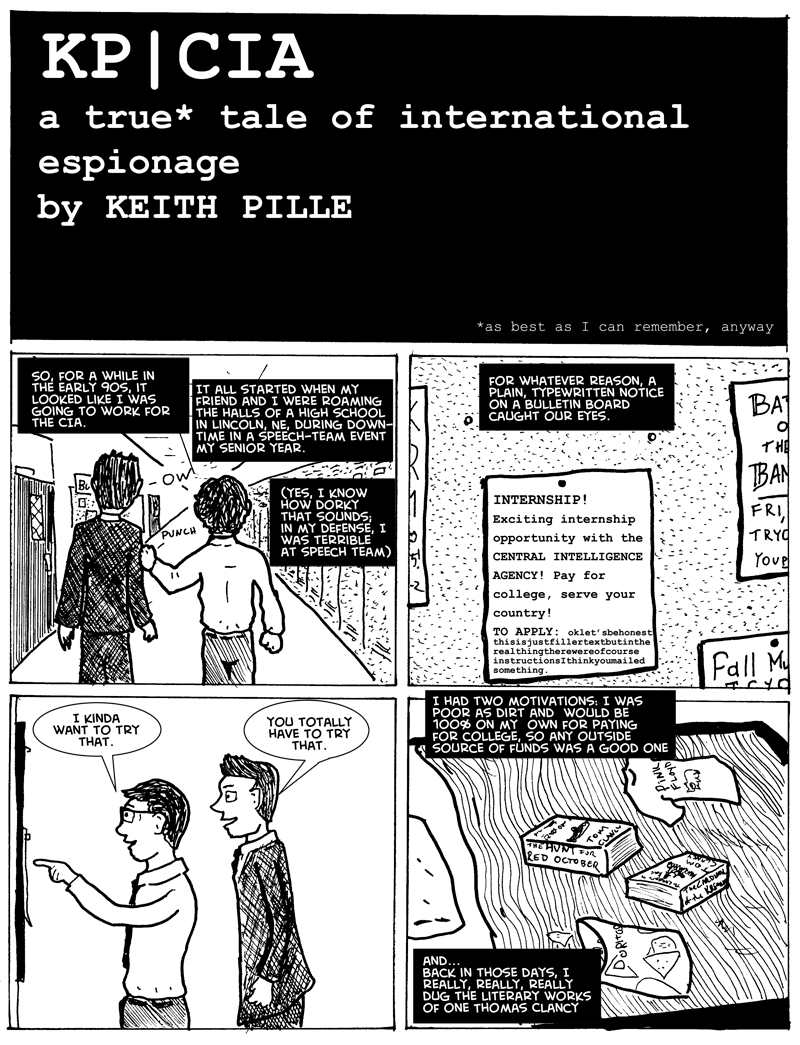
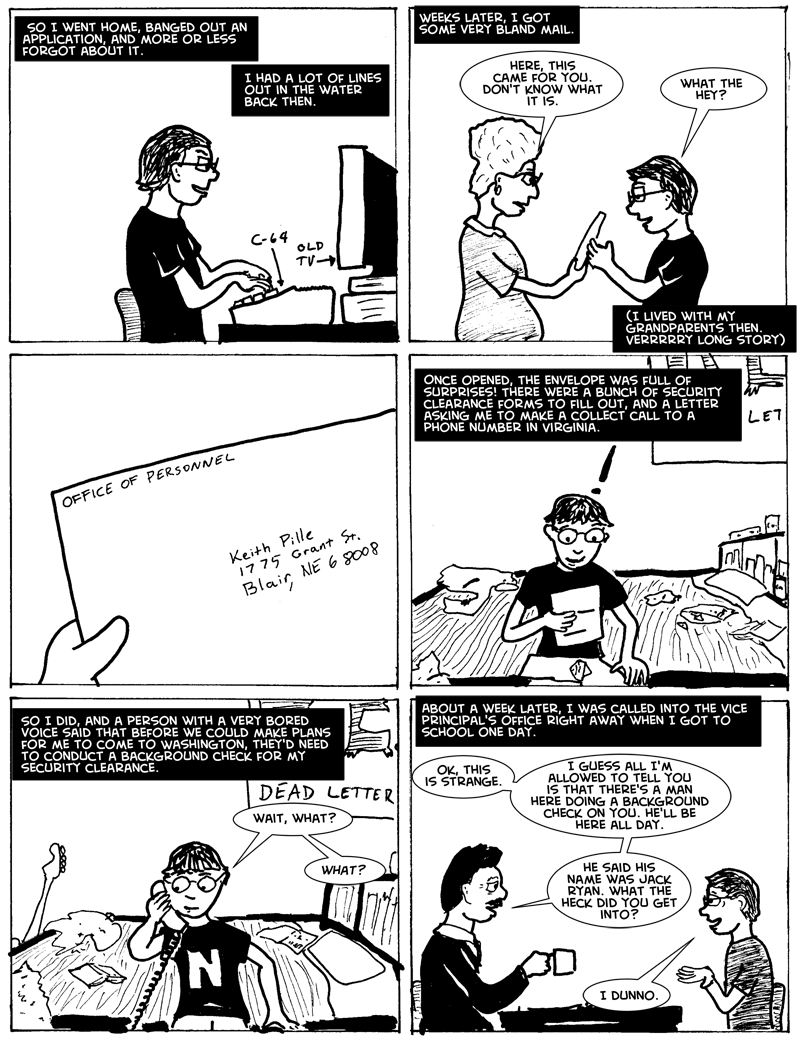


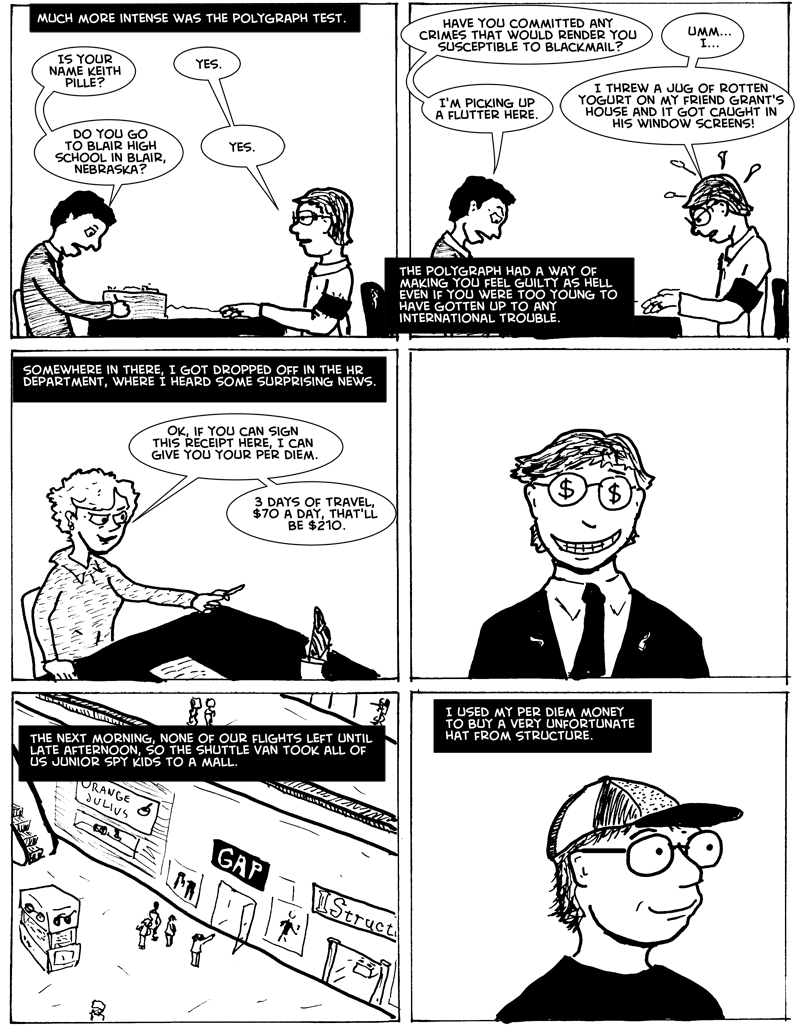


A Couple of Comics about Music Production
What the title says. Made these as sort of a detour from narrative Nowhere Band strips, but they don’t really belong over there. So here they are. Will probably do more at some point….
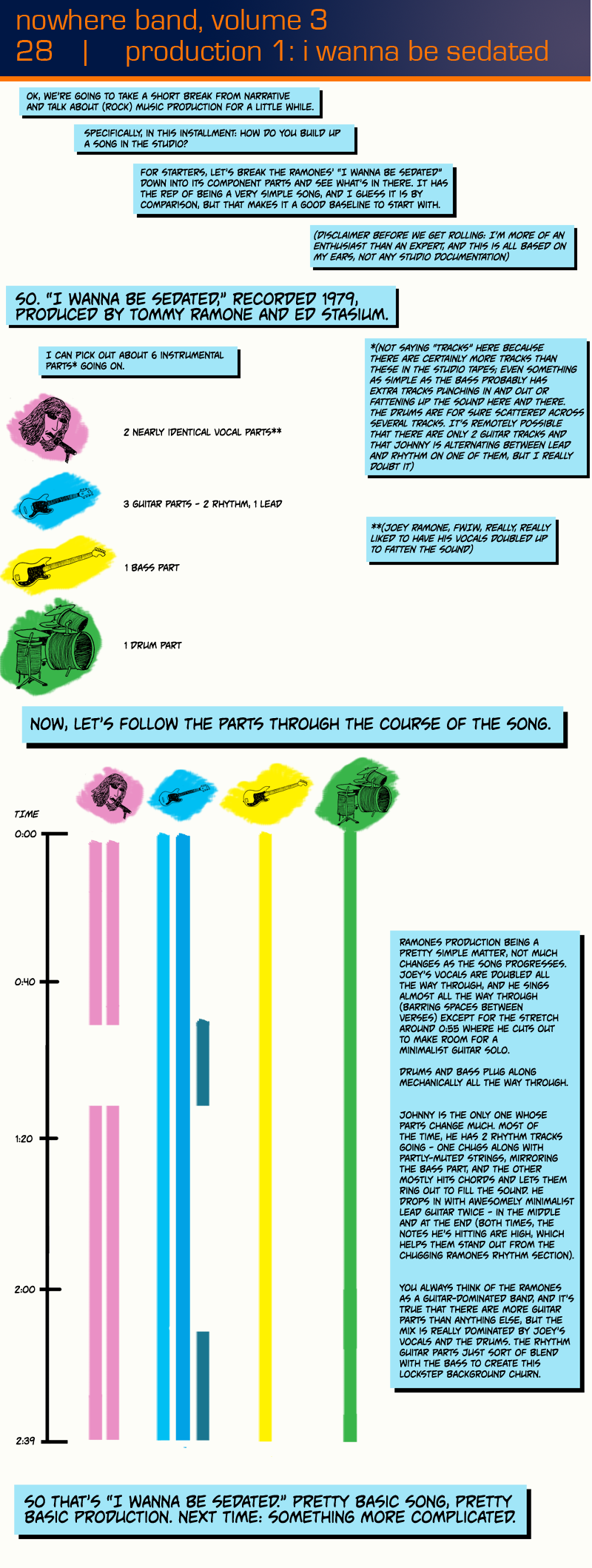

A Walk Through the Process of Creating Nowhere Band
A couple of friends have asked me about the nuts and bolts of how I put a Nowhere Band strip together; I’m in kind of a dead spot as I recover from a vacation and wait for class to start, so I thought now would be a good time to do a quick walkthrough of the process. So (click on all pictures to embiggen):
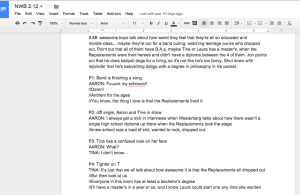 STEP 1 : SCRIPT
STEP 1 : SCRIPT
Naturally, I start with a script. Actually, that’s not true. I start with a vague idea that gets jotted down in a notebook or a google doc, and then fluffed out to a badly-written paragraph with chunks of dialogue embedded, and then on to a full-on script.
My scripts are pretty minimal (and casual as far as spelling and grammar and those niceties), since I’m just writing for myself and I’ve already internalized all kinds of strip conventions about locations, expressions, gestures, and such. At this point, it’d be really weird to write a script for someone else to draw. I should try it some time.
The hardest thing in the script stage is making sure lines of dialogue don’t get too long to fit gracefully into balloons. I can get pretty wordy – I still basically think of myself as a writer who sort of knows how to draw – so this is a challenge.
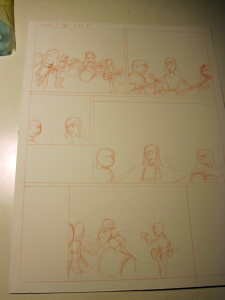 STEP 2 : REDLINE
STEP 2 : REDLINE
This is the worst step; in any sort of creative work, the hardest part is sitting down and facing a blank piece of paper, and that’s what’s going on here. Everything after this point is basically a form of editing and refinement, cleaning up or enhancing something that already exists. Here, I’m wrestling something into existence. Mornings when I wake up and have to go downstairs and do redlines are the times I’m most tempted to sleep in or volunteer to walk the dog on Rebecca’s day of the rotation.
Anyway: I start out by laying out the panel grid in red pencil (doing this stage in red makes it easy to remove all of this rough early work in Photoshop once the strip’s scanned). The script’ll tell me how many panels I need (I try to keep it around 5, give or take a couple, but different strips need different lengths). Relative panel size usually comes down to a function of how much dialog is in a given panel (remember, I get wordy), how big a thing or space needs to be shown, or how many characters appear.
Continue reading A Walk Through the Process of Creating Nowhere Band
Rumours
This is one of the first long-form comics I ever drew, back when I was pretty clearly just beginning to learn how to draw. It’s an adaption of an excellent essay / short story by Twin Cities music writer Jim Walsh, who was nice enough to let me take his words out for a spin. Resurrected because Fleetwood Mac seems to be having some kind of goddamned renaissance.
Longevity and Comics and Who the Hell Knows What Else
OK.
I’ve been talking on and on all summer about wrapping up Nowhere Band this year. The idea was pretty simple: I’m turning 40 at the end of the year, and on some level it felt weird to me to think about continuing to do a strip about dudes in a band after I’d turned 40. Especially since it’s been a good 3 years since I’ve had an active band going. There was a bunch of burnout involved as well, much of it centered around a bunch of rules I’ve imposed on myself.
But now that I’ve thought things over and life has calmed down a bit, I think I’m going to keep the strip going. Part of what convinced me was the abrupt realization that some of my favorite comics are Jaime Hernandez’ ongoing run; he obviously didn’t feel weird about making comics about aging punks as he whizzed past 40, so why should I? Also, I recognized that lots of the things that were bothering me were completely self-inflicted. Tired of fighting with Photoshop in the coloring stage? You can always go back to black and white for a while. Feeling pressed by self-imposed posting deadlines? Who gives a shit? It’ll come out when it comes out. Don’t want every story to center on the band? Fine, they all have outside lives, tell some stories there.
The truth is that I do love the strip. Somehow, sneakily, it seems to have become my life’s work. I can live with that. I didn’t mean for it to be when I started out… but at least for now it feels like that’s where things are. I guess that gives some shape to my 20s- I wasn’t wasting my time in half-assed bands, I was gathering material. You always wish more people read a strip when you put this much work into it, but I love the readers that I have. people whose tastes and worldviews I respect tell me they like it; that means a ton to me.
So I think I’m going to keep going. I might structure things so that stories or even sections of life have clear starts and ends, but that’s the sort of thing that’s easy to say you’re going to do and then forget. So we’ll see. And I’m sure that there will be breaks and hiatuses at points as I work on prose stuff or other comics. But for the time being, Nowhere Band’s going to chug on. Even if (gasp) the Awesome Boys don’t, necessarily.
The Doctor Is In
Here’s a comic strip I worked up, kind of a prototype for a thing I might pursue after I finish Nowhere Band (which should be some time this year, unless I change my mind). I think this thing would mutate a little more if it actually went into production, but if nothing else I’ve got a pretty big google doc full of script ideas…
And yeah, inspired by Charles Schulz, of course.
Updated: I did indeed change my mind.
Catonia Lends a Hand
America’s Next Top Novelist
The comic project I did back in 2007 immediately before starting Nowhere Band. I think this was a good script, but my art skillz were clearly still a work in progress. Note that I borrowed a couple of character designs for NWB.
The Very First Cartoon I Ever Drew
Disasters and Recoveries and Education and the Return of Nowhere Band
![]() Let’s start with the executive summary: After being in creative exile, more or less, for the past 4 months, I started work this morning on bringing back my old rock strip Nowhere Band. The new volume will, somewhat recursively, follow the Awesome Boys as they try to get their band back together after a long hiatus and deal with the fact that they’re now edging into being older than their musical peers. First new strip should go up some time next week. It should be funny and human. I’m stoked.
Let’s start with the executive summary: After being in creative exile, more or less, for the past 4 months, I started work this morning on bringing back my old rock strip Nowhere Band. The new volume will, somewhat recursively, follow the Awesome Boys as they try to get their band back together after a long hiatus and deal with the fact that they’re now edging into being older than their musical peers. First new strip should go up some time next week. It should be funny and human. I’m stoked.
Continue reading Disasters and Recoveries and Education and the Return of Nowhere Band
Why So Quiet?
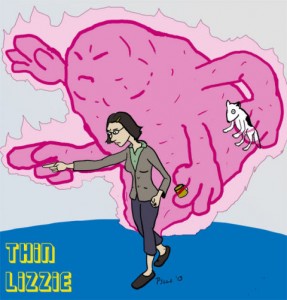 Well, it’s simple… since I work for a university, I recently became eligible for free tuition for grad-level classes, so a couple of months ago I started a master’s program in software. Which I’m sure will pay off in the long run, but in the short term it’s kind of meant tossing a hand grenade into my life as I knew it. Work on EYEBALL continues, but at a drastically-reduced pace; I don’t know that I’ll finish more than 4 or 5 pages this semester (although then it’ll pick up over the summer, at least for a while).
Well, it’s simple… since I work for a university, I recently became eligible for free tuition for grad-level classes, so a couple of months ago I started a master’s program in software. Which I’m sure will pay off in the long run, but in the short term it’s kind of meant tossing a hand grenade into my life as I knew it. Work on EYEBALL continues, but at a drastically-reduced pace; I don’t know that I’ll finish more than 4 or 5 pages this semester (although then it’ll pick up over the summer, at least for a while).
Stuff’s still happening, though. Before the coursework shit really started hitting the fan, I had time to work something up for Andrew Weiss’ Ultimate Powers Jam, and I’m actually happier with it than I am with pretty much any creative thing I’ve done for the past year. So there’s that.
In the meantime, yeah. I’m still around, and still working on comics at a snail’s pace. When I’m not fighting with Python.
An Ancient Comic: Pacmania
New project, page 1
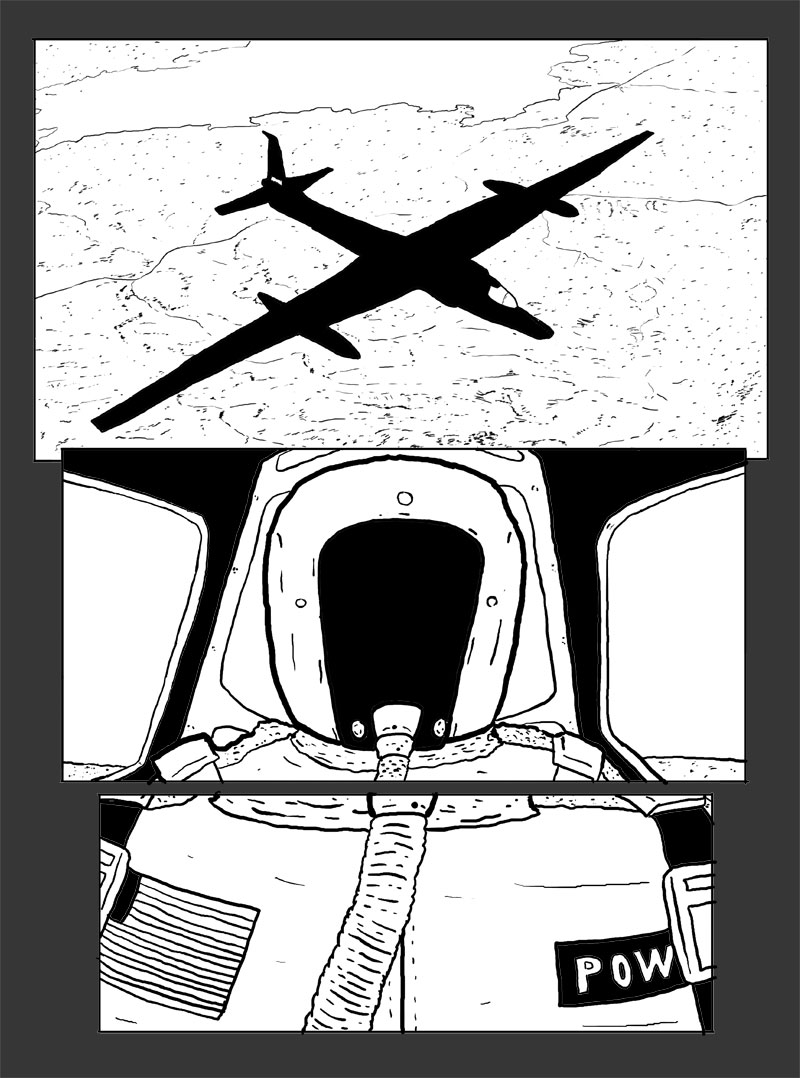 So, here’s what I’ve been working on. This is the inked (but not colored or lettered) first page of a graphic novel I’m setting out on. This should be a pretty big project, and I’m actually not sure what my endgame will be as far as getting it out into the world- I want to have a big chunk of pages put together before I start thinking about whether or not to run it serially online, for instance.
So, here’s what I’ve been working on. This is the inked (but not colored or lettered) first page of a graphic novel I’m setting out on. This should be a pretty big project, and I’m actually not sure what my endgame will be as far as getting it out into the world- I want to have a big chunk of pages put together before I start thinking about whether or not to run it serially online, for instance.
The project is (temporarily) called Eyeball, and it’s about spyplanes in the early 60s. Or about not getting too lost in your job, depending on which way you want to look at it.
This one’s been gestating for quite a while; I wrote out the original plot and started scripting in 2006. I was really excited about the project, but eventually bailed because 1) I didn’t think I could draw well enough to do it justice, and 2) the thought of doing all of the visual research to get the look and feel right for a story set in 1960 just scared the piss out of me. But now I’m 6 years better at drawing (I still think it’ll be a challenge, but it’s actually possible this time) and, well, Mad Men has gone and done me the favor of researching what things looked like in 1960.
So we’ll see where this goes.
